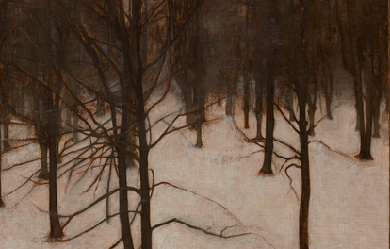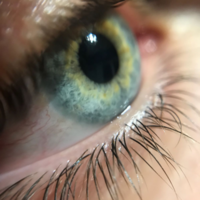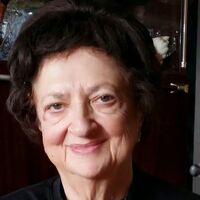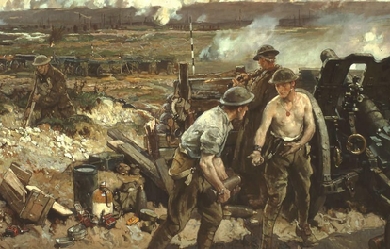
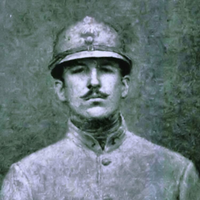
Alan Seeger (22 June 1888– 4 July 1916) was an American poet who fought and died in World War I during the Battle of the Somme serving in the French Foreign Legion. Seeger was the uncle of American folk singer Pete Seeger, and was a classmate of T.S. Eliot at Harvard. He is most well known for having authored the poem, I Have a Rendezvous with Death, a favorite of President John F. Kennedy. A statue modeled after Seeger is found on the monument honoring fallen Americans who volunteered for France during the war, located at the Place des États-Unis, Paris. He is sometimes called the “American Rupert Brooke.” Early life Born in New York on June 22, 1888, Seeger moved with his family to Staten Island at the age of one and remained there until the age of 10. In 1900, his family moved to Mexico for two years, which influenced the imagery of some of his poetry. His brother Charles Seeger, a noted pacifist and musicologist, was the father of the American folk singers Peter “Pete” Seeger, Mike Seeger, and Margaret “Peggy” Seeger. Seeger entered Harvard in 1906 after attending several elite preparatory schools, including Hackley School. Writing At Harvard, he edited and wrote for the Harvard Monthly. Among his friends there (and afterward) was the American Communist John Reed, though the two had differing ideological views, and his Harvard class also included T.S. Eliot and Walter Lippmann, among others. After graduating in 1910, he moved to Greenwich Village for two years, where he wrote poetry and enjoyed the life of a young bohemian. During his time in Greenwich Village, he attended soirées at the Mlles. Petitpas’ boardinghouse (319 West 29th Street), where the presiding genius was the artist and sage John Butler Yeats, father of the poet William Butler Yeats. Having moved to the Latin Quarter of Paris to continue his seemingly itinerant intellectual lifestyle, on August 24, 1914, Seeger joined the French Foreign Legion so that he could fight for the Allies in World War I (the United States did not enter the war until 1917). Death He was killed in action at Belloy-en-Santerre on July 4, 1916, famously cheering on his fellow soldiers in a successful charge after being hit several times by machine gun fire. Poetry Seeger’s poetry was published by Charles Scribner’s Sons in December 1916 with a 46-page introduction by William Archer. Poems, a collection of his works, was relatively unsuccessful, due, according to Eric Homberger, to its lofty idealism and language, qualities out of fashion in the early decades of the 20th century. Poems was reviewed in The Egoist, where the critic—T. S. Eliot, Seeger’s classmate at Harvard—commented that, Seeger was serious about his work and spent pains over it. The work is well done, and so much out of date as to be almost a positive quality. It is high-flown, heavily decorated and solemn, but its solemnity is thorough going, not a mere literary formality. Alan Seeger, as one who knew him can attest, lived his whole life on this plane, with impeccable poetic dignity; everything about him was in keeping. One of his more famous poems was I Have a Rendezvous with Death, published posthumously. A recurrent theme in both his poetic works and his personal writings was his desire for his life to end gloriously at an early age. This particular poem, according to the JFK Library, “was one of John F. Kennedy’s favorite poems and he often asked his wife (Jacqueline) to recite it.” Memorials On 4 July 1923, the President of the French Council of State, Raymond Poincaré, dedicated a monument in the Place des États-Unis to the Americans who had volunteered to fight in World War I in the service of France. The monument, in the form of a bronze statue on a plinth, executed by Jean Boucher, had been financed through a public subscription. Boucher had used a photograph of Seeger as his inspiration, and Seeger’s name can be found, among those of 23 others who had fallen in the ranks of the French Foreign Legion, on the back of the plinth. Also, on either side of the base of the statue, are two excerpts from Seeger’s “Ode in Memory of the American Volunteers Fallen for France”, a poem written shortly before his death on 4 July 1916. Seeger intended that his words should be read in Paris on 30 May of that year, at an observance of the American holiday, Decoration Day (later known as Memorial Day): They did not pursue worldly rewards; they wanted nothing more than to live without regret, brothers pledged to the honor implicit in living one’s own life and dying one’s own death. Hail, brothers! Goodbye to you, the exalted dead! To you, we owe two debts of gratitude forever: the glory of having died for France, and the homage due to you in our memories. Alan Seeger Natural Area, in central Pennsylvania, was named by Colonel Henry Shoemaker. It is unknown if Alan Seeger had any connection to the area or why Shoemaker chose to memorialize the poet. The area is known for its virgin trees. References Wikipedia—https://en.wikipedia.org/wiki/Alan_Seeger
Nací el 12 de diciembre de 2006 en Puerto Rico, La isla del Encanto. 🏝 🇵🇷 (Actualmente 17 años) Mi pasión es la lectura, el canto, el dibujo, los instrumentos musicales, los animales y la poesía... Mi amor por la lectura comenzó desde que leí la Biblia por primera vez. Cada palabra desbordada de verdad dirigió cada una de mis sendas y mi vida se llenó de verdadero propósito. Más tarde, comencé a escribir poesías, irónicamente sin saber que era una poesía. Al cabo de un año, aprendí más a fondo de lo que se trataba la poesía. Actualmente, no he podido parar de escribir y es uno de los amores de mi vida. Para mí, la poesía es la hermosa vestidura del alma de aquellas personas que buscan derramar sus más sinceros sentimientos. Así como las telas cubren nuestro cuerpo, las poesías con sus cálidos mantos cubren nuestro ser, alivian nuestro dolor y avivan nuestra pasión. ❤️🔥 "Que sus palabras sean siempre agradables, sazonadas con sal, para que sepan cómo deben responder a cada persona." (Colosenses 4:6)
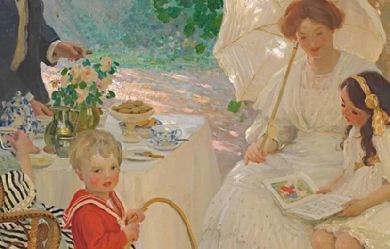
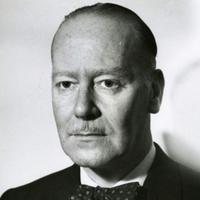
Kenneth Adolf Slessor OBE (27 March 1901– 30 June 1971) was an Australian poet, journalist and official War Correspondent in World War II. He was one of Australia’s leading poets, notable particularly for the absorption of modernist influences into Australian poetry. The Kenneth Slessor Prize for Poetry is named after him. Early life Slessor was born Kenneth Adolphe Schloesser in Orange, New South Wales. As a boy, he lived in England for a time with his parents and in Australia visited the mines of rural New South Wales with his father, a Jewish mining engineer whose father and grandfather had been distinguished musicians in Germany. His family moved to Sydney in 1903. Slessor attended Mowbray House School (1910–1914) and the Sydney Church of England Grammar School (1915–1918), where he began to write poetry. His first published poem was in 1917 about a digger in Europe, remembering Sydney and its icons. Slessor passed the 1918 NSW Leaving Certificate with first-class honours in English and joined the Sydney Sun as a journalist. In 1919, seven of his poems were published. He married for the first time in 1922. Career Slessor made his living as a newspaper journalist, mostly for the Sydney Sun, and was a war correspondent during World War II (1939–1945). Slessor counted Norman Lindsay, Hugh McCrae and Jack Lindsay among his friends. As the Australian Official War Correspondent during World War II, Slessor reported not only from Australia but from Greece, Syria, Libya, Egypt, and New Guinea. Slessor also wrote on rugby league football for the popular publication Smith’s Weekly. Poetry The bulk of Slessor’s poetic work was produced before the end of the Second World War. His poem “Five Bells”—relating to Sydney Harbour, time, the past, memory, and the death of the artist, friend and colleague of Slessor at Smith’s Weekly, Joe Lynch—remains probably his best known poem, followed by “Beach Burial”, a tribute to Australian troops who fought in World War II. In 1965, Australian writer Hal Porter wrote of having met and stayed with Slessor in the 1930s. He described Slessor as: ...a city lover, fastidious and excessively courteous, in those qualities resembles Baudelaire, as he does in being incapable of sentimentalizing over vegetation, in finding in nature something cruel, something bordering on effrontery. He prefers chiselled stone to the disorganization of grass. Awards In the New Year’s Honours of 1959, Slessor was appointed an Officer of the Order of the British Empire (OBE) for services to literature. Personal life At the age of 21, Slessor married 28-year-old Noëla Glasson in Ashfield, Sydney, on 18 August 1922. Noëla died of cancer on 22 October 1945. He married Pauline Wallace in 1951; and a year later celebrated the birth of his only child, Paul Slessor, before the marriage dissolved in 1961. Death He died alone and suddenly of a heart attack on 30 June 1971 at the Mater Misericordiae Hospital, North Sydney. Bibliography Poetry collections * Thief of the Moon, Sydney: Hand press of J. T. Kirtley (1924) * Earth-Visitors, London: Fanfrolico Press (1926) * Trio: a book of poems, with Harley Matthews and Colin Simpson, Sydney: Sunnybrook Press (1931) * Cuckooz Contrey, Sydney: Frank Johnson (1932) * Darlinghurst Nights: and Morning glories: being 47 strange sights, Sydney (1933) * Funny Farmyard: Nursery Rhymes and Painting Book, with drawings by Sydney Miller, Sydney: Frank Johnson (1933) * Five Bells: XX Poems, Sydney: F.C. Johnson (1939) * One Hundred Poems, 1919–1939, Sydney: Angus & Robertson (1944) * “Beach Burial” 1944 * “The Night Ride” * “Sleep” * “Out of Time” 1930 Essays/prose * Bread and Wine, Sydney, Angus & Robertson (1970) Edited * Australian Poetry (1945) * The Penguin Book of Modern Australian Verse (Melbourne, 1961) Recognition Slessor has a street in the Canberra suburb of McKellar named after him. The bells motif in “Five Bells” is referenced at the end of the 1999 song “You Gotta Love This City” by The Whitlams, which also involves a drowning death in Sydney Harbour. Slessor’s poetry was chosen to be placed on the Higher School Certificate English reading lists, and was also examined in the final English exam. References Wikipedia—https://en.wikipedia.org/wiki/Kenneth_Slessor
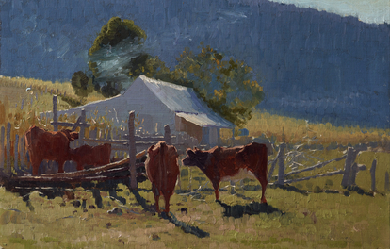
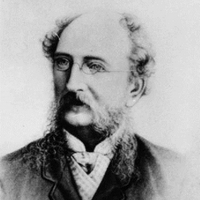
James Brunton Stephens (17 June 1835– 29 June 1902) was a Scottish-born Australian poet, author of Convict Once. Born at Borrowstounness, on the Firth of Forth, Scotland; the son of John Stephens, the parish schoolmaster, and his wife Jane, née Brunton. J. B. Stephens was educated at his father’s school, then at a free boarding school and at the University of Edinburgh from 1849 to 1854 without obtaining a degree. For three years he was a travelling tutor on the continent, and from 1859 became a school teacher in Scotland. While teaching at Greenock Academy, Stephens wrote some minor verse and two short novels ('Rutson Morley’ and 'Virtue Le Moyne’) which were published in Sharpe’s London Magazine in 1861-63.
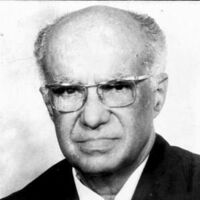
Rogelio Sinán, seudónimo de Bernardo Domínguez Alba (Taboga, 1902 - Panamá, 1994) fue un escritor vanguardista panameño. Inició sus estudios en el Colegio De La Salle y se graduó de bachiller en el Instituto Nacional de Panamá (1924). Realizó estudios universitarios en Chile, en donde conoció a los poetas Pablo Neruda y Gabriela Mistral. Siguiendo consejo de la poetisa, viaja a Italia a aprender italiano; fue allí donde se empapó de los -ismos (dadaísmo, surrealismo, creacionismo, ultrarealísmo, etc.) en boga en Europa en esa época y que serían la base de su obra posteriormente. En 1989, la Universidad de Panamá lo distinguió con el Doctorado Honori0 Vida profesional En Panamá, ejerció como profesor de español, en el Instituto Nacional y de arte dramático en la Universidad de Panamá. Posteriormente desempeñó el cargo de Primer Secretario de la Embajada de Panamá en México y, en 1938, como Cónsul de Panamá en Calcuta, India. Nuevamente en Panamá, en 1946 fue Director del Departamento de Bellas Artes y Publicaciones del Ministerio de Educación. Fue miembro de la Academia Panameña de la Lengua. Premios y distinciones * Casa de Rogelio Sinán en la Isla de Taboga * Premio Ricardo Miró de Novela por su libro "Plenilunio". Panamá, 1943. * Premio Interamericano de Cuento, por su cuento "La boina roja". México, 1949. * Premio "Ricardo Miró" de Poesía por su libro "Semana Santa en la niebla". Panamá, 1949. * Premio "Ricardo Miró" de Novela por su libro "La isla mágica". Panamá, 1977. + El gobierno panameño le otorgó tres condecoraciones en vida. La Academia Panameña de * la Lengua le otorgó la Primera Orden al Mérito Intelectual. * Actualmente se entregan tres premios literarios en su honor: el Premio Centroamericano de Literatura "Rogelio Sinán", que desde 1996 convoca para libros inéditos en los géneros cuento, novela y poesía la Universidad Tecnológica de Panamá; y la Condecoración + "Rogelio Sinán" que la República de Panamá otorga cada dos años a un autor panameño por la excelencia en la obra de toda una vida. Obra literaria La obra con que Sinán se dio a conocer fue la colección de poemas Onda (1929), publicado en Roma, Italia. Con este poemario, Sinán rompe con la estética del modernismo, cultivada por los poetas románticos panameños hasta la fecha, e inicia el vanguardismo en Panamá. Esta obra representó un cambio en la visión poética del mundo y en la forma de expresión con respecto a la poesía que se practicaba en Panamá en ese momento. Aparte de la poesía, Sinán cultivó el género del cuento y la novela, y en menor medida el teatro infantil y el ensayo. Poesía * Onda. Casa Editrice, Roma, Italia, 1929; Segunda edición, Revista "Lotería", No. 11, Panamá, septiembre de 1964; Tercera edición, Ediciones Formato Dieciséis, Universidad de Panamá, 1983. * Incendio. Cuadernos de poesía "Mar del Sur", No. 1, Panamá, 1944. * Semana Santa en la niebla. Panamá, 1949; Segunda edición, Dirección Nacional de Cultura del Ministerio de Educación, Panamá, 1969. * Saloma sin salomar. Dirección Nacional de Publicaciones del Ministerio de Educación, Panamá, 1969. * Poesía completa de Rogelio Sinán. Prólogo de Elsie Alvarado de Ricord, compilación e introducción de Enrique Jaramillo Levi. Universidad Tecnológica de Panamá, abril de 2000. Cuento * A la orilla de las estatuas maduras. Panamá, 1946; Secretaría de Educación Pública, México, 1967. * Todo un conflicto de sangre. Panamá, 1946. * Dos aventuras en el lejano oriente. Panamá, 1947; Panamá, 1953. * La boina roja y otros cuentos. Panamá, 1954; Ediciones del Ministerio de Educación, Panamá, 1961; Madrid, 1972. Posteriormente se han seguido publicando múltiples ediciones sin las últimas tres palabras del título original. * Los pájaros del sueño. Panamá, 1957. * Cuna común. Ediciones de la revista “Tareas”, Panamá, 1963. * Cuentos de Rogelio Sinán. Editorial Universitaria Centroamericana, San José (Costa Rica), 1971; 1972. * Homenaje a Rogelio Sinán. Poesía y Cuento. Prólogo de Enrique Jaramillo Levi, Editorial Signos, México, 1982. * El candelabro de los malos ofidios y otros cuentos. Editorial Signos, Panamá, 1982. Novela * Plenilunio. Panamá,1947; México, 1953; Panamá, 1961; Madrid, 1972. Posteriormente se ha seguido publicando múltiples ediciones en Panamá. * La isla mágica. Instituto Nacional de Cultura, Panamá, 1979; Segunda edición, Ediciones * Casa de las Américas, Habana, Cuba, 1985 . Teatro infantil * La cucarachita mandinga (farsa, adaptación de una historia tradicional de la India). Panamá, 1937; Segunda edición, Instituto Nacional de Cultura, Panamá, 1992. * Chiquilinga (farsa). Panamá, 1961. * Lobo go home (escenificada en Panamá, pero no publicada como libro). Ensayo * Los valores humanos en la lírica de Maples Arce. México, 1959. * Otros ensayos aparecidos en revistas y periódicos en diversas épocas fueron reunidos por Enrique Jaramillo Levi en: “Maga, Revista panameña de cultura”, No. 5-6, Panamá, enero-junio de 1985. REferencias Wikipedia-http://es.wikipedia.org/wiki/Rogelio_Sin%C3%A1n
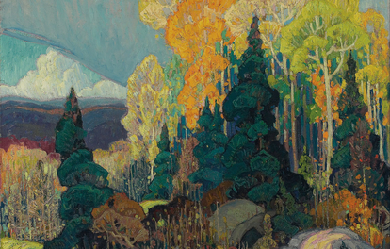
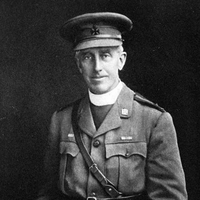
Frederick George Scott (7 April 1861– 19 January 1944) was a Canadian poet and author, known as the Poet of the Laurentians. He is sometimes associated with Canada’s Confederation Poets, a group that included Charles G.D. Roberts, Bliss Carman, Archibald Lampman, and Duncan Campbell Scott. Scott published 13 books of Christian and patriotic poetry. Scott was a British imperialist who wrote many hymns to the British Empire—eulogizing his country’s roles in the Boer Wars and World War I. Many of his poems use the natural world symbolically to convey deeper spiritual meaning. Frederick George Scott was the father of poet F. R. Scott.
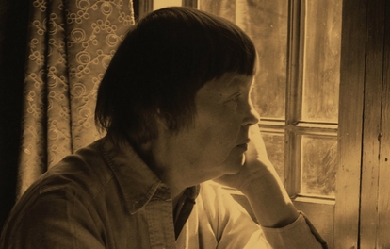
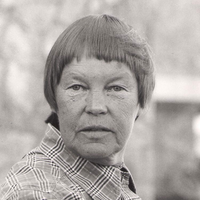
Anna Thilda May “May” Swenson (28 May 1913– 4 December 1989) was an American poet and playwright. She is considered one of the most important and original poets of the 20th century, as often hailed by the noted critic Harold Bloom. The first child of Margaret and Dan Arthur Swenson, she grew up as the eldest of ten children in a Mormon household where Swedish was spoken regularly and English was a second language. As a lesbian, she was somewhat shunned by her family for religious reasons. Much of her later poetry works were devoted to children. She also translated the work of contemporary Swedish poets, including the selected poems of Nobel laureate Tomas Tranströmer.
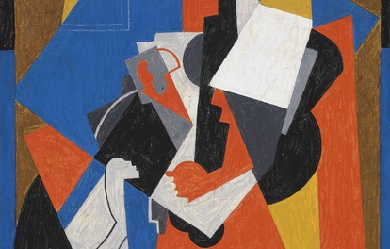
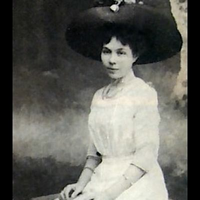
Cécile Sauvage, « poétesse de la maternité »ne femme de lettres française, née à La Roche-sur-Yon le 20 juillet 1883 et morte le 26 août 1927. Biographie De 1888 à 1907, elle vécut à Digne-les-Bains, dans une maison située avenue de Verdun, où est apposée une plaque qui lui rend hommage. Étudiante au lycée de Digne, elle envoie un manuscrit Les Trois Muses à La Revue forézienne, dont le rédacteur est Pierre Messiaen. Ils échangent une correspondance, puis se marient « Notre mariage eut lieu le 9 septembre 1907, en l’église des Sieyes, près Digne (Basses-Alpes) » . Ils seront les parents d’Alain Messiaen et Olivier Messiaen qu’elle éleva, selon ce dernier, dans un « univers féerique ». Le couple est uni et heureux ; Cécile dédie Primevère à son cher Pierrot, en souvenir de nos fiançailles et de notre mariage. Elle vécut la majeure partie de sa vie à Saint-Étienne[réf. nécessaire], et écrit chaque jour à sa petite table de bois blanc tachée d’encre. Elle découvre les poètes anglais, dont Keats dont le vers La poésie de la terre ne meurt jamais semble être écrit pour illustrer la poésie de Cécile Sauvage. Elle s’installe à Grenoble avec ses fils alors que son époux part au front de la guerre 14/18 ; puis la famille vivra à Paris, qui n’attire pas la poétesse. De santé fragile, elle s’éteint le 26 août 1927, dans les bras de son époux et de ses fils. Son ami Henri Pourrat lui a consacré un ouvrage, La Veillée de novembre.

I am a very passionate winsome lad,my name is Vusumzi Mathews Sono born in the year of 1989 the 28th of December and I was born here in South Africa at a place called Cape Town,grew up in Eastern Cape.Vusi is a nickname coming from my full name Vusumzi and Oulik is just a nickname given by friends it is a Afrikaans name and it means "cute" .I never knew that one day I would be enthusiastic about poetry,but I loved writting since primary school,but then we used to just write songs that didn't even make sense but because I've never had an easy life as a child so I took out my emotions on writing as I was writing I noticed that everything I wrote was just poetic even at school when we were suppose to do orals,presentations or just anything I ended up flowing poetically,then that is when I found my first love "POETRY" inspired by roman ancient movies and some of Celine Dion's songs e.g the titanic song.
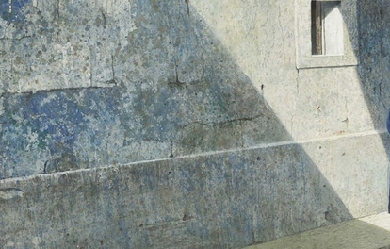
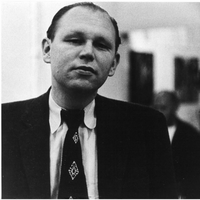
Jack Spicer (January 30, 1925– August 17, 1965) was an American poet often identified with the San Francisco Renaissance. In 2009, My Vocabulary Did This to Me: The Collected Poetry of Jack Spicer won the American Book Award for poetry. Life and work Spicer was born in Los Angeles, where he later graduated from Fairfax High School in 1942, and attended the University of Redlands from 1943-45. He spent most of his writing-life in San Francisco and spent the years 1945 to 1950 and 1952 to 1955 at the University of California, Berkeley, where he began writing, doing work as a research-linguist, and publishing some poetry (though he disdained publishing). During this time he searched out fellow poets, but it was through his alliance with Robert Duncan and Robin Blaser that Spicer forged a new kind of poetry, and together they referred to their common work as the Berkeley Renaissance. The three, who were all gay, also educated younger poets in their circle about their “queer genealogy”, Rimbaud, Lorca, and other gay writers. Spicer’s poetry of this period is collected in One Night Stand and Other Poems (1980). His Imaginary Elegies, later collected in Donald Allen’s The New American Poetry 1945-1960 anthology, were written around this time. In 1954, he co-founded the Six Gallery in San Francisco, which soon became famous as the scene of the October 1955 Six Gallery reading that launched the West Coast Beat movement. In 1955, Spicer moved to New York and then to Boston, where he worked for a time in the Rare Book Room of Boston Public Library. Blaser was also in Boston at this time, and the pair made contact with a number of local poets, including John Wieners, Stephen Jonas, and Joe Dunn. Spicer returned to San Francisco in 1956 and started working on After Lorca. This book represented a major change in direction for two reasons. Firstly, he came to the conclusion that stand-alone poems (which Spicer referred to as his one-night stands) were unsatisfactory and that henceforth he would compose serial poems. In fact, he wrote to Blaser that 'all my stuff from the past (except the Elegies and Troilus) looks foul to me.' Secondly, in writing After Lorca, he began to practice what he called “poetry as dictation”. His interest in the work of Federico García Lorca, especially as it involved the cante jondo ideal, also brought him near the poetics of the deep image group. The Troilus referred to was Spicer’s then unpublished play of that name. The play finally appeared in print in 2004, edited by Aaron Kunin, in issue 3 of No - A Journal of the Arts. In 1957, Spicer ran a workshop called Poetry as Magic at San Francisco State College, which was attended by Duncan, Helen Adam, James Broughton, Joe Dunn, Jack Gilbert, and George Stanley. He also participated in, and sometimes hosted, Blabbermouth Night at a literary bar called The Place. This was a kind of contest of improvised poetry and encouraged Spicer’s view of poetry as being dictated to the poet. After many years of alcohol abuse, Spicer fell into a prehepatic coma in his apartment building elevator, and later died aged 40 in the poverty ward of San Francisco General Hospital on August 17, 1965. Legacy Spicer’s view of the role of language in the process of writing poetry was probably the result of his knowledge of modern pre-Chomskyan linguistics and his experience as a research-linguist at Berkeley. In the legendary Vancouver lectures he elucidated his ideas on “transmissions” (dictations) from the Outside, using the comparison of the poet as crystal-set or radio receiving transmissions from outer space, or Martian transmissions. Although seemingly far-fetched, his view of language as “furniture”, through which the transmissions negotiate their way, is grounded in the structuralist linguistics of Zellig Harris and Charles Hockett. (In fact, the poems of his final book, Language, refer to linguistic concepts such as morphemes and graphemes). As such, Spicer is acknowledged as a precursor and early inspiration for the Language poets. However, many working poets today list Spicer in their succession of precedent figures. Spicer died as a result of his alcoholism. Since the posthumous publication of The Collected Books of Jack Spicer (first published in 1975), his popularity and influence has steadily risen, affecting poetry throughout the United States, Canada, and Europe. In 1994, The Tower of Babel: Jack Spicer’s Detective Novel was published. Adding to the Jack Spicer revival was the publication in 1998 of two volumes: The House That Jack Built: The Collected Lectures of Jack Spicer, edited by Peter Gizzi; and a biography: Jack Spicer and the San Francisco Renaissance by Lewis Ellingham and Kevin Killian (Hanover, NH: Wesleyan University Press, 1998). A collected works entitled My Vocabulary Did This to Me: The Collected Poetry of Jack Spicer (Peter Gizzi and Kevin Killian, editors) was published by Wesleyan University Press in November 2008, and won the American Book Award in 2009. A collection of critical essays entitled After Spicer: Critical Essays (John Emil Vincent, editor) was published by Wesleyan University Press in 2011. Further reading Blaser, Robin, editor. The Collected Books of Jack Spicer. Santa Rosa, Calif.: Black Sparrow Press, 1975 A Book Of Correspondences For Jack Spicer. Edited By David Levi Strauss and Benjamin Hollander. San Francisco: A Journal of Acts (#6), 1987; (Note: this is a collection of essays, poetry, and documents celebrating Spicer) Diaman, N. A.. Following My Heart: A Memoir. San Francisco: Persona Press, May 2007 _____. The City: A Novel. San Francisco: Persona Press, August 2007 _____. Sitting With Jack At The Poets Table. Los Angeles: The Advocate, 1984 _____. Second Crossing: A Novel. San Francisco: Persona Press, 1982 Ellingham, Lewis, and Kevin Killian. Poet, Be Like God: Jack Spicer and the San Francisco Renaissance. Middletown, Conn.: Wesleyan University Press, 1998 Foster, Edward Halsey. Jack Spicer. Boise, Idaho: Boise State University, 1991 Gizzi, Peter, editor. The House that Jack Built: The Collected Lectures of Jack Spicer. Hanover, NH: Wesleyan University Press, 1998 Spicer, Jack. Jack Spicer’s Beowulf, Part 1, edited by David Hadbawnik & Sean Reynolds, introduction by David Hadbawnik, Lost and Found: The CUNY Poetics Documents Initiative, New York, 2011 _____. Jack Spicer’s Beowulf, Part II, edited by David Hadbawnik & Sean Reynolds, afterword by Sean Reynolds, Lost and Found: The CUNY Poetics Documents Initiative, New York, 2011 Tallman, Warren. In the Midst. Vancouver: Talonbooks, 1992 Herndon, James. Everything as Expected San Francisco, 1973 Vincent, John Emil, editor. After Spicer: Critical Essays. Middletown, Conn.: Wesleyan University Press, 2011 References Wikipedia—https://en.wikipedia.org/wiki/Jack_Spicer
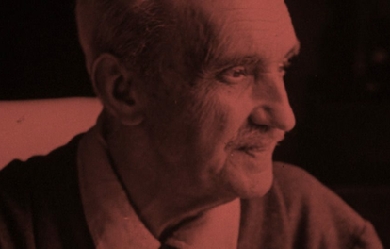
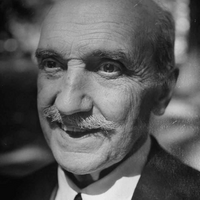
Jorge Agustín Nicolás Ruiz de Santayana y Borrás, k (nown in English as George Santayana (/ˌsæntiˈænə/ or /-ˈɑːnə/; December 16, 1863– September 26, 1952), was a philosopher, essayist, poet, and novelist. Originally from Spain, Santayana was raised and educated in the United States from the age of eight and identified himself as an American, although he always kept a valid Spanish passport. He wrote in English and is generally considered an American man of letters. At the age of forty-eight, Santayana left his position at Harvard and returned to Europe permanently, never to return to the United States. His last wish was to be buried in the Spanish pantheon in Rome. Santayana is popularly known for aphorisms, such as “Those who cannot remember the past are condemned to repeat it,” “Only the dead have seen the end of war,”, and the definition of beauty as “pleasure objectified”. Although an atheist, he always treasured the Spanish Catholic values, practices and world-view with which he was brought up. Santayana was a broad-ranging cultural critic spanning many disciplines. Early life Born Jorge Agustín Nicolás Ruiz de Santayana y Borrás on December 16, 1863, in Madrid, he spent his early childhood in Ávila, Spain. His mother, Josefina Borrás, was the daughter of a Spanish official in the Philippines, and Jorge was the only child of her second marriage. She was the widow of George Sturgis, a Boston merchant with whom she had five children, two of whom died in infancy. She lived in Boston for a few years following her husband’s death in 1857, but in 1861 moved with her three surviving children to live in Madrid. There she encountered Agustín Ruiz de Santayana, an old friend from her years in the Philippines. They married in 1862. A colonial civil servant, Ruiz de Santayana was also a painter and minor intellectual. The family lived in Madrid and Ávila until 1869, when Josefina Borrás de Santayana returned to Boston with her three Sturgis children, as she had promised her first husband to raise the children in the United States. She left the six-year-old Jorge with his father in Spain. Jorge and his father followed her in 1872, but his father, finding neither Boston nor his wife’s attitude to his liking, soon returned alone to Ávila. He remained there the rest of his life. Jorge did not see him again until he entered Harvard College and took his summer vacations in Spain. Sometime during this period, Jorge’s first name was anglicized as George, the English equivalent. Education Santayana attended Boston Latin School and Harvard College, where he studied under the philosophers William James and Josiah Royce and was involved in eleven clubs as an alternative to athletics. He was founder and president of the Philosophical Club, a member of the literary society known as the O.K., an editor and cartoonist for The Harvard Lampoon, and co-founder of the literary journal The Harvard Monthly. In December, 1885, he played the role of Lady Elfrida in the Hasty Pudding theatrical Robin Hood, followed by the production Papillonetta in the spring of his senior year. After graduating Phi Beta Kappa from Harvard in 1886, Santayana studied for two years in Berlin. He then returned to Harvard to write his dissertation on Hermann Lotze and teach philosophy, becoming part of the Golden Age of the Harvard philosophy department. Some of his Harvard students became famous in their own right, including T. S. Eliot, Robert Frost, Gertrude Stein, Horace Kallen, Walter Lippmann, and W. E. B. Du Bois. Wallace Stevens was not among his students but became a friend. From 1896 to 1897, Santayana studied at King’s College, Cambridge. Later life In 1912, Santayana resigned his position at Harvard to spend the rest of his life in Europe. He had saved money and been aided by a legacy from his mother. After some years in Ávila, Paris and Oxford, after 1920, he began to winter in Rome, eventually living there year-round until his death. During his forty years in Europe, he wrote nineteen books and declined several prestigious academic positions. Many of his visitors and correspondents were Americans, including his assistant and eventual literary executor, Daniel Cory. In later life, Santayana was financially comfortable, in part because his 1935 novel, The Last Puritan, had become an unexpected best-seller. In turn, he financially assisted a number of writers, including Bertrand Russell, with whom he was in fundamental disagreement, philosophically and politically. Santayana never married. His romantic life, if any, is not well understood. Some evidence, including a comment Santayana made late in life comparing himself to A. E. Housman, and his friendships with people who were openly homosexual and bisexual, has led scholars to speculate that Santayana was perhaps homosexual or bisexual himself, but it remains unclear whether he had any actual heterosexual or homosexual relationships. Philosophical work and publications Santayana’s main philosophical work consists of The Sense of Beauty (1896), his first book-length monograph and perhaps the first major work on aesthetics written in the United States; The Life of Reason five volumes, 1905–6, the high point of his Harvard career; Scepticism and Animal Faith (1923); and The Realms of Being (4 vols., 1927–40). Although Santayana was not a pragmatist in the mold of William James, Charles Sanders Peirce, Josiah Royce, or John Dewey, The Life of Reason arguably is the first extended treatment of pragmatism written. Like many of the classical pragmatists, and because he was well-versed in evolutionary theory, Santayana was committed to metaphysical naturalism. He believed that human cognition, cultural practices, and social institutions have evolved so as to harmonize with the conditions present in their environment. Their value may then be adjudged by the extent to which they facilitate human happiness. The alternate title to The Life of Reason, “the Phases of Human Progress,” is indicative of this metaphysical stance. Santayana was an early adherent of epiphenomenalism, but also admired the classical materialism of Democritus and Lucretius (of the three authors on whom he wrote in Three Philosophical Poets, Santayana speaks most favorably of Lucretius). He held Spinoza’s writings in high regard, calling him his “master and model.” Although an atheist, he held a fairly benign view of religion, in contrast to Bertrand Russell who held that religion was harmful. Santayana’s views on religion are outlined in his books Reason in Religion, The Idea of Christ in the Gospels, and Interpretations of Poetry and Religion. Santayana described himself as an “aesthetic Catholic.” He spent the last decade of his life at the Convent of the Blue Nuns of the Little Company of Mary on the Celian Hill at 6 Via Santo Stefano Rotondo in Rome, where he was cared for by the Irish sisters. Man of letters Santayana’s one novel, The Last Puritan, is a bildungsroman, centering on the personal growth of its protagonist, Oliver Alden. His Persons and Places is an autobiography. These works also contain many of his sharper opinions and bons mots. He wrote books and essays on a wide range of subjects, including philosophy of a less technical sort, literary criticism, the history of ideas, politics, human nature, morals, the influence of religion on culture and social psychology, all with considerable wit and humor. While his writings on technical philosophy can be difficult, his other writings are far more accessible and pithy. He wrote poems and a few plays, and left an ample correspondence, much of it published only since 2000. Like Alexis de Tocqueville, Santayana observed American culture and character from a foreigner’s point of view. Like William James, his friend and mentor, he wrote philosophy in a literary way. Ezra Pound includes Santayana among his many cultural references in The Cantos, notably in “Canto LXXXI” and “Canto XCV”. Santayana is usually considered an American writer, although he declined to become an American citizen, resided in fascist Italy for decades, and said that he was most comfortable, intellectually and aesthetically, at Oxford University. Awards * Royal Society of Literature Benson Medal, 1925. * Columbia University Butler Gold Medal, 1945. * Honorary degree from the University of Wisconsin, 1911. Legacy * Santayana is remembered in large part for his aphorisms, many of which have been so frequently used as to have become clichéd. His philosophy has not fared quite as well. He is regarded by most as an excellent prose stylist, and Professor John Lachs (who is sympathetic with much of Santayana’s philosophy) writes, in On Santayana, that his eloquence may ironically be the very cause of this neglect. * Santayana influenced those around him, including Bertrand Russell, who Santayana single-handedly steered away from the ethics of G. E. Moore. He also influenced many prominent people such as Harvard students T. S. Eliot, Robert Frost, Gertrude Stein, Horace Kallen, Walter Lippmann, W. E. B. Du Bois, Conrad Aiken, Van Wyck Brooks, and Supreme Court Justice Felix Frankfurter, as well as Max Eastman and the poet Wallace Stevens. Stevens was especially influenced by Santayana’s aesthetics and became a friend even though Stevens did not take courses taught by Santayana. * Santayana is quoted by the Canadian-American sociologist Erving Goffman as a central influence in the thesis of his famous book The Presentation of Self in Everyday Life (1959). Religious historian Jerome A. Stone credits Santayana with contributing to the early thinking in the development of religious naturalism. English mathematician and philosopher Alfred North Whitehead quotes Santayana extensively in his magnum opus Process and Reality. * Chuck Jones used Santayana’s description of fanaticism as “redoubling your effort after you’ve forgotten your aim” to describe his cartoons starring Wile E. Coyote and Road Runner. Bibliography * * 1894. Sonnets And Other Verses. * 1896. The Sense of Beauty: Being the Outline of Aesthetic Theory. * 1899. Lucifer: A Theological Tragedy. * 1900. Interpretations of Poetry and Religion. * 1901. A Hermit of Carmel And Other Poems. * 1905–1906. The Life of Reason: or the Phases of Human Progress, 5 vols. * 1910. Three Philosophical Poets: Lucretius, Dante, and Goethe. * 1913. Winds of Doctrine: Studies in Contemporary Opinion. * 1915. Egotism in German Philosophy. * 1920. Character and Opinion in the United States: With Reminiscences of William James and Josiah Royce and Academic Life in America. * 1920. Little Essays, Drawn From the Writings of George Santayana. by Logan Pearsall Smith, With the Collaboration of the Author. * 1922. Soliloquies in England and Later Soliloquies. * 1922. Poems. * 1923. Scepticism and Animal Faith: Introduction to a System of Philosophy. * 1926. Dialogues in Limbo * 1927. Platonism and the Spiritual Life. * 1927–40. The Realms of Being, 4 vols. * 1931. The Genteel Tradition at Bay. * 1933. Some Turns of Thought in Modern Philosophy: Five Essays * 1935. The Last Puritan: A Memoir in the Form of a Novel. * 1936. Obiter Scripta: Lectures, Essays and Reviews. Justus Buchler and Benjamin Schwartz, eds. * 1944. Persons and Places. * 1945. The Middle Span. * 1946. The Idea of Christ in the Gospels; or, God in Man: A Critical Essay. * 1948. Dialogues in Limbo, With Three New Dialogues. * 1951. Dominations and Powers: Reflections on Liberty, Society, and Government. * 1953. My Host The World * Posthumous edited/selected works * 1955. The Letters of George Santayana. Daniel Cory, ed. Charles Scribner’s Sons. New York. (296 letters) * 1956. Essays in Literary Criticism of George Santayana. Irving Singer, ed. * 1957. The Idler and His Works, and Other Essays. Daniel Cory, ed. * 1967. The Genteel Tradition: Nine Essays by George Santayana. Douglas L. Wilson, ed. * 1967. George Santayana’s America: Essays on Literature and Culture. James Ballowe, ed. * 1967. Animal Faith and Spiritual Life: Previously Unpublished and Uncollected Writings by George Santayana With Critical Essays on His Thought. John Lachs, ed. * 1968. Santayana on America: Essays, Notes, and Letters on American Life, Literature, and Philosophy. Richard Colton Lyon, ed. * 1968. Selected Critical Writings of George Santayana, 2 vols. Norman Henfrey, ed. * 1969. Physical Order and Moral Liberty: Previously Unpublished Essays of George Santayana. John and Shirley Lachs, eds. * 1979. The Complete Poems of George Santayana: A Critical Edition. Edited, with an introduction, by W. G. Holzberger. Bucknell University Press. * 1995. The Birth of Reason and Other Essays. Daniel Cory, ed., with an Introduction by Herman J. Saatkamp, Jr. Columbia Univ. Press. * 2009. The Essential Santayana. Selected Writings Edited by the Santayana Edition, Compiled and with an introduction by Martin A. Coleman. Bloomington: Indiana University Press. * The Works of George Santayana * Unmodernized, critical editions of George Santayana’s published and unpublished writing. The Works is edited by the Santayana Edition and published by The MIT Press. * 1986. Persons and Places. Santayana’s autobiography, incorporating Persons and Places, 1944; The Middle Span, 1945; and My Host the World, 1953. * 1988 (1896). The Sense of Beauty: Being the Outline of Aesthetic Theory. * 1990 (1900). Interpretations of Poetry and Religion. * 1994 (1935). The Last Puritan: A Memoir in the Form of a Novel. * The Letters of George Santayana. Containing over 3,000 of his letters, many discovered posthumously, to more than 350 recipients. * 2001. Book One, 1868–1909. * 2001. Book Two, 1910–1920. * 2002. Book Three, 1921–1927. * 2003. Book Four, 1928–1932. * 2003. Book Five, 1933–1936. * 2004. Book Six, 1937–1940. * 2006. Book Seven, 1941–1947. * 2008. Book Eight, 1948–1952. * 2011. George Santayana’s Marginalia: A Critical Selection, Books 1 and 2. Compiled by John O. McCormick and edited by Kristine W. Frost. * The Life of Reason in five books. * 2011 (1905). Reason in Common Sense. * 2013 (1905). Reason in Society. * 2014 (1905). Reason in Religion. References Wikipedia—https://en.wikipedia.org/wiki/George_Santayana
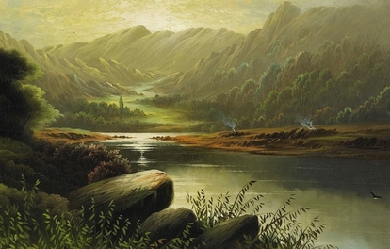
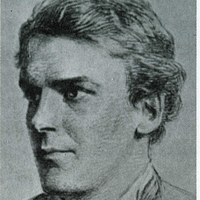
James Kenneth Stephen (25 February 1859– 3 February 1892) was an English poet, and tutor to Prince Albert Victor, eldest son of Albert Edward, Prince of Wales. Early life Stephen was the second son of Sir James Fitzjames Stephen, barrister-at-law, and his wife Mary Richenda Cunningham. James Kenneth Stephen was known as 'Jem’ among his family and close friends; he was first cousin to Virginia Woolf (née Stephen). He was a King’s Scholar at Eton, where he proved to be a highly competent player of the Eton Wall Game; and then went up to King’s College, Cambridge, again as a King’s Scholar. In the Michaelmas term of 1880, he was President of the Cambridge Union Society. In 1883 he became tutor to Prince Albert Victor, Duke of Clarence and Avondale, and was made a Fellow of King’s College in 1885. He was a renowned intellectual; and it was said that he spoke in a pedantic, but highly articulate and entertaining manner. Poetry Stephen became a published poet, his work being identified by the initials J. K. S. His collections of poems Lapsus Calami and Quo Musa Tendis were both published in 1891. Rudyard Kipling called him “that genius” and told how he “dealt with Haggard and me in some stanzas which I would have given much to have written myself”. Those stanzas, in which Stephen deplores the state of contemporary writing, appear in his poem ‘To R. K.’: Will there never come a season Which shall rid us from the curse Of a prose which knows no reason And an unmelodious verse: When the world shall cease to wonder At the genius of an Ass, And a boy's eccentric blunder Shall not bring success to pass: When mankind shall be delivered From the clash of magazines, And the inkstand shall be shivered Into countless smithereens: When there stands a muzzled stripling, Mute, beside a muzzled bore: When the Rudyards cease from Kipling And the Haggards Ride no more. “The Last Ride Together (From Her Point of View)” parodies Robert Browning’s “Last Ride Together”; Lord Byron is parodied in “A Grievance”; and William Wordsworth in “A Sonnet”: Two voices are there: one is of the deep; It learns the storm-cloud's thunderous melody, Now roars, now murmurs with the changing sea, Now bird-like pipes, now closes soft in sleep: And one is of an old half-witted sheep Which bleats articulate monotony, And indicates that two and one are three, That grass is green, lakes damp, and mountains steep: And, Wordsworth, both are thine J. K Stephen was at Cambridge at the same time as the distinguished antiquarian and writer of ghost-stories, Montague R. James, and mentions him at the end of a curious Latin celebration of then-current worthies of 'Coll. Regale’ (King’s College): Vivat J.K. Stephanus, Humilis poeta! Vivat Monty Jamesius, Vivant A, B, C, D, E Et totus Alphabeta! Stephen wrote a satirical pastiche of Thomas Gray’s “Ode to the Distant Prospect of Eton College” pillorying Eton for being Tory. A poem which gave him a reputation as a misogynist is “Men and Women,” where he describes two people, a man and a woman, whom he does not know but to whom he takes a violent dislike. The first part, subtitled “In the Backs” (The Backs is a riverside area of Cambridge), concludes ...I do not want to see that girl again: I did not like her: and I should not mind If she were done away with, killed, or ploughed. She did not seem to serve a useful end: And certainly she was not beautiful. (Plough is slang for failing an exam.) However many of his other poems show that this “misogyny” Is more accurately described as only one facet of a sardonic nature. Stephen was a member of the Cambridge “Apostles”. Death Stephen suffered a serious head injury in an accident in the winter of 1886/1887 which may have exacerbated the bi-polar disorder from which he suffered. His cousin Virginia Woolf suffered from the same disorder throughout her adult life. Stephen was eventually committed to St Andrew’s Hospital, a mental asylum in Northampton. In January 1892 the former Royal tutor heard that his erstwhile pupil, the 28-year-old Prince Albert Victor, Duke of Clarence had died of pneumonia at Sandringham, after contracting influenza. On hearing the news, Stephen refused to eat, and died twenty days later, aged 32. His cause of death, according to the death certificate, was mania. Eton legacies Stephen was noted for his prodigious size and physical strength. At Eton, he was an outstanding player of the Wall Game. He played for College on St Andrew’s Day four times: in 1874, 1875, 1876 and 1877. In the last two years he was Keeper (or captain) of the College Wall. College beat the Oppidans by 4 shies to nil in his first year as Keeper, and by 10 shies to nil the next year. Ever after, the King’s Scholars have honoured J K Stephen’s memory with a toast at the Christmas Sock Supper or other festive occasions - in piam memoriam, J. K. S. (In pious memory of J. K. S.). Stephen was recalled in less pious memory in a play by former Eton housemaster and Old Etonian, Angus Graham-Campbell; entitled Sympathy for the Devil, it premiered at the Eton Drama festival in 1993. This was based on the notion that Stephen could have been one of the Jack the Ripper suspects; this theory has been dismissed, because he would have been unable to return to Cambridge in time for lectures the following morning. Stephen’s poem The Old School List from Quo Musa Tendis is included in the front pages of H. E. C. Stapleton’s Eton School Lists 1853-1892, and the author refers to him in the preface as 'an Etonian of great promise, who died only too early for his numerous friends’. During his time at Eton, Stephen was a friend of Harry Goodhart (1858–1895), who became an England international footballer and later a Professor at the University of Edinburgh. Goodhart is referred to as “one of them’s wed” in the last verse of The Old School List: There were two good fellows I used to know. —How distant it all appears! We played together in football weather, And messed together for years: Now one of them's wed, and the other's dead So long that he's hardly missed Save by us, who messed with him years ago: But we're all in the old School List. Collections Select Poems 1926 Augustan Books of Modern Poetry Lapsus Calami JKS Cambridge 1891 Quo Musa Tendis Cambridge 1891 Lapsus Calami and other verses 1896 References Wikipedia—https://en.wikipedia.org/wiki/James_Kenneth_Stephen
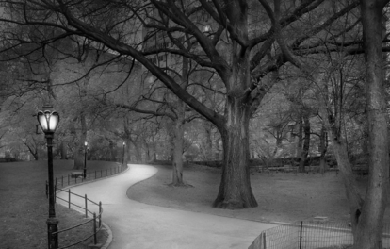

“La poesía es una bellísima doncella, casta, honesta, discreta, aguda, retirada, y que se contiene en los límites de la discreción más alta. Es amiga de la soledad, las fuentes la entretienen, los prados la consuelan, los árboles la desenojan, las flores la alegran, y, finalmente, deleita y enseña a cuantos con ella comunican.” Miguel de Cervantes.
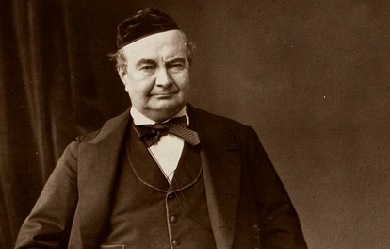

Charles-Augustin Sainte-Beuve est un critique litté, raire et écrivain français, né le 23 décembre 1804 à Boulogne-sur-Mer et mort le 13 octobre 1869 à Paris. La méthode critique de Sainte-Beuve se fonde sur le fait que l’œuvre d’un écrivain serait avant tout le reflet de sa vie et pourrait s’expliquer par elle. Elle se fonde sur la recherche de l’intention poétique de l’auteur (intentionnisme) et sur ses qualités personnelles (biographisme). Cette méthode a été critiquée par la suite. Marcel Proust, dans son essai Contre Sainte-Beuve, est le premier à la contester, reprochant de plus à Sainte-Beuve de négliger, voire condamner de grands auteurs comme Baudelaire, Stendhal ou Balzac. L’école formaliste russe, ainsi que les critiques Ernst Robert Curtius et Leo Spitzer, suivront Proust dans cette route. Cette opposition entre Sainte-Beuve et Proust peut aussi se comprendre comme un renversement de perspective de la critique littéraire. En effet, il faut reconnaître à Sainte-Beuve une capacité de critique formelle fondée: il l’a montré avec le Salammbô de Flaubert, si bien que Flaubert lui-même en tint compte dans la suite de son œuvre. Seulement, chez lui, cette analyse semble devoir rester subordonnée à la connaissance de la vie de l’auteur, et c’est là que s’opère le renversement proustien: si rapport il y a entre l’œuvre et la vie de son auteur, pour Proust c’est bien la première qui doit apparaître comme la plus riche source d’enseignements sur le sens profond de la seconde. Ce renversement est à la base de la poétique de Proust et s’incarne dans À la recherche du temps perdu. S’il est moins connu du grand public de nos jours, entre 1870 et au moins jusqu’aux années 1950, il est resté longtemps l’une des figures majeures du panthéon littéraire transmis par l’école républicaine, avec Victor Hugo, Montaigne ou Lamartine, et tous les écoliers connaissaient au moins son nom. Biographie Né à Moreuil le 6 novembre 1752, le père de l’auteur, Charles-François Sainte-Beuve, contrôleur principal des droits réunis et conseiller municipal à Boulogne-sur-Mer, se marie le 30 nivôse an XII (21 janvier 1804) avec Augustine Coilliot, fille de Jean-Pierre Coilliot, capitaine de navire, née le 22 novembre 1764. Toutefois, atteint par une angine, il meurt le 12 vendémiaire an XIII (4 octobre 1804). Orphelin de père dès sa naissance le 2 nivôse an XIII (23 décembre 1804) à Boulogne-sur-Mer, Sainte-Beuve est élevé par sa mère et une tante paternelle, veuve également. En 1812, il entre en classe de sixième comme externe libre à l’institution Blériot, à Boulogne-sur-Mer, où il reste jusqu’en 1818. À cette époque, il obtient de poursuivre ses études à Paris. Placé dans l’institution Landry en septembre 1818, il suit comme externe les cours du collège Charlemagne, de la classe de troisième à la première année de rhétorique, puis ceux du collège Bourbon, où il a pour professeur Paul-François Dubois, en seconde année de rhétorique et en philosophie. En 1822, il est lauréat du Concours général, remportant le premier prix de poésie latine. Après l’obtention de son baccalauréat ès lettres, le 18 octobre 1823, il s’inscrit à la faculté de médecine le 3 novembre. Puis, conformément à l’ordonnance du 2 février 1823, qui l’exige pour les professions médicales, il prend des leçons particulières de mathématiques et passe le baccalauréat ès sciences, le 17 juillet 1824. Toutefois, alors qu’il a été nommé en 1826 externe à l’hôpital Saint-Louis avec une chambre, il abandonne ses études de médecine en 1827 pour se consacrer aux lettres. Après un article anonyme paru le 24 octobre 1824, il publie dans Le Globe, journal libéral et doctrinaire fondé par son ancien professeur, Paul-François Dubois, un article signé « Joseph Delorme » le 4 novembre. Le 2 et le 9 janvier 1827, il publie une critique élogieuse des Odes et ballades de Victor Hugo, et les deux hommes se lient d’amitié. Ensemble, ils assistent aux réunions au Cénacle de Charles Nodier à la Bibliothèque de l’Arsenal. Il a une liaison avec l’épouse de Hugo, Adèle Foucher. Le 20 septembre 1830, Sainte-Beuve et l’un des propriétaires du journal Le Globe, Paul-François Dubois, se battent en duel dans les bois de Romainville. Sous la pluie, ils échangent quatre balles sans résultats. Sainte-Beuve conserva son parapluie à la main, disant qu’il voulait bien être tué mais pas mouillé. Après l’échec de ses romans, Sainte-Beuve se lance dans les études littéraires, dont la plus connue est Port-Royal, et collabore notamment à La Revue contemporaine. Port-Royal (1837-1859), le chef-d’œuvre de Saint-Beuve, décrit l’histoire de l’abbaye de Port-Royal des Champs, de son origine à sa destruction. Ce livre résulte d’un cours donné à l’Académie de Lausanne entre le 6 novembre 1837 et le 25 mai 1838. Cette œuvre a joué un rôle important dans le renouvellement de l’histoire religieuse. Certains historiens qualifient Port-Royal de « tentative d’histoire totale ». Élu à l’Académie française le 14 mars 1844 au fauteuil de Casimir Delavigne, il est reçu le 27 février 1845 par Victor Hugo. Il est à noter que ce dernier portait néanmoins sur leurs relations un regard désabusé: « Sainte-Beuve, confiait-il à ses carnets en 1876, n’était pas poète et n’a jamais pu me le pardonner . » En 1848-1849, il accepte une chaire à l’université de Liège, où il donne un cours consacré à Chateaubriand et son groupe littéraire, qu’il publie en 1860. À partir d’octobre 1849, il publie, successivement dans Le Constitutionnel, Le Moniteur et Le Temps des feuilletons hebdomadaires regroupés en volumes sous le nom de Causeries du lundi, leur titre venant du fait que le feuilleton paraissait chaque lundi. À la différence de Hugo, il se rallie au Second Empire en 1852. Le 13 décembre 1854, il obtient la chaire de poésie latine au Collège de France, mais sa leçon inaugurale sur « Virgile et L’Énéide », le 9 mars 1855, est perturbée par des étudiants qui veulent dénoncer son ralliement. Il doit alors envoyer, le 20 mars, sa lettre de démission. Par la suite, le 3 novembre 1857, il est nommé maître de conférences à l’École normale supérieure, où il donne des cours de langue et de littérature françaises de 1858 à 1861. Sous l’Empire libéral, il est nommé au Sénat, où il siège du 28 avril 1865 jusqu’à sa mort en 1869. Dans ces fonctions, il défend la liberté des lettres et la liberté de penser. Réception Friedrich Nietzsche, pourtant adversaire déclaré de Sainte-Beuve, a incité en 1880 Ida Overbeck, femme de son ami Franz Overbeck, à traduire les Causeries du lundi en allemand. Jusque-là, Sainte-Beuve n’avait jamais été publié en allemand, malgré sa grande importance en France, car considéré en Allemagne comme représentant d’une manière détestable et typiquement française de penser. La traduction d’Ida Overbeck est parue en 1880 sous le titre Menschen des XVIII. Jahrhunderts (« l’être humain au XVIIIe siècle »). Nietzsche a écrit à Ida Overbeck le 18 août 1880: « Il y a une heure que j’ai reçu Menschen des XVIII. Jahrhunderts. [...] C’est un livre merveilleux, je crois que j’ai pleuré, et ce serait bizarre si ce petit livre ne pouvait pas exciter la même sensation chez beaucoup d’autres personnes ». La traduction d’Ida Overbeck est un document important du transfert culturel entre l’Allemagne et la France, mais fut largement ignorée. En 2014 apparut la première édition critique et annotée. Charles Maurras s’inspire directement de la méthode d’analyse du critique littéraire pour forger sa methode d’analyse politique, l’empirisme organisateur, qui aboutira chez lui au nationalisme intégral,. Œuvres Poésie * Vie, poésies et pensées de Joseph Delorme (1829) * Les Consolations (1830) * Pensées d’août (1837) * Livre d’amour (1843) * Poésies complètes (1863) Romans et nouvelles * Volupté (1834)– réédité par S.E.P.E. en 1947 avec illustrations de Marguerite Bermond. * Madame de Pontivy (1839) * Christel (1839) * Le Clou d’or qu’il dédia à Sophie de Bazancourt, femme de lettres et épouse du général François Aimé Frédéric Loyré d’Arbouville. * La Pendule (1880) Critique * Tableau historique et critique de la poésie française et du théâtre français au XVIe siècle (1828), 2 volumes * Port-Royal (1840-1859), 5 volumes * Portraits littéraires (1844 et 1876-78), 3 volumes * Portraits contemporains (1846 et 1869-71), 5 volumes * Portraits de femmes (1844 et 1870) * Les Lundis * Causeries du lundi (1851-1862), 16 volumes * Nouveaux lundis (1863-1870), 13 volumes * Premiers lundis (1874-75), 3 volumes * Étude sur Virgile (1857). Texte de cette étude annoté par Henri Goelzer en 1895. * Chateaubriand et son groupe littéraire (1860), 2 volumes * Le Général Jomini (1869) * Madame Desbordes-Valmore: sa vie et sa correspondance (1870) * M. de Talleyrand (1870) * P.-J. Proudhon (1872) * Chroniques parisiennes (1843-1845 et 1876) * Les cahiers de Sainte-Beuve (1876) * Mes poisons (1926): carnet secret édité à titre posthume Correspondance * Lettres à la princesse (Mathilde) (1873) * Correspondance (1877-78), 2 volumes * Nouvelle correspondance (1880) * Lettres à Collombet (1903) * Correspondance avec M. et Mme Juste Olivier (1904) * Lettres à Charles Labitte (1912) * Lettres à deux amies (1948) * Lettres à George Sand * Lettres à Adèle Couriard * Correspondance générale, 19 volumes Biographie * Le général Jomini, étude, Paris 1869. Texte sur Gallica Hommage * Denys Puech (1854-1942), Monument à Sainte-Beuve, 1898, Paris, jardin du Luxembourg. Les références Wikipedia – https://fr.wikipedia.org/wiki/Charles-Augustin_Sainte-Beuve
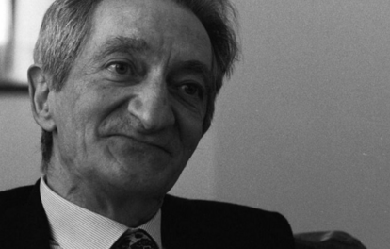
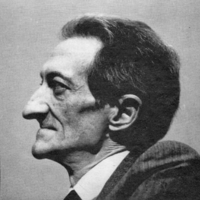
Edoardo Sanguineti (Genova, 9 dicembre 1930 – Genova, 18 maggio 2010) è stato un poeta, scrittore e politico italiano, che fece parte del Gruppo 63. Biografia Figlio unico di Giovanni, impiegato di banca nato a Chiavari, e di Giuseppina Cocchi, torinese, si trasferì all’età di quattro anni a Torino, città nella quale il padre aveva trovato un nuovo impiego come amministratore cassiere presso la tipografia Doyen & Marchisio. Era ancora bambino quando, durante una normale visita di controllo, gli venne diagnosticata una grave malattia cardiaca. La diagnosi si rivelò in seguito errata ma questo episodio ha condizionato per lungo tempo lo stile di vita del poeta.A Torino abitava uno zio di Edoardo, Luigi Cocchi, musicista e musicologo, che aveva conosciuto Gobetti e Gramsci e aveva collaborato alla rivista L’Ordine Nuovo e che sarebbe stato il primo punto di riferimento per la formazione del giovane. A Bordighera, dove il giovane trascorreva le vacanze estive, Edoardo frequentava il cugino Angelo Cervetto, appassionato di musica che gli trasmette la passione per il jazz, e Guido Seborga, che lo inizia alla lettura di Artaud. Nel frattempo, in seguito alla pertosse che aveva contratto, il giovanissimo Edoardo venne visitato da uno specialista che individuò l’errore diagnostico del quale era stato vittima. Edoardo era sanissimo ma da quel momento dovette fare intensi esercizi fisici per recuperare il tono muscolare. Ginnastica, ciclismo, tennis furono da quel momento gli sport che avrebbe dovuto intensamente affiancare allo studio, anche se dovette rinunciare alla sua primaria ispirazione: quella di dedicarsi alla danza. 1946-1955: studi, elaborazione di Laborintus, primi contatti culturali Nel 1946 Edoardo s’iscrisse al Liceo classico Massimo d’Azeglio ed ebbe come insegnante d’italiano Luigi Vigliani. A lui avrebbe dedicato il saggio su Gozzano e gli avrebbe fatto leggere alcune poesie che saranno in seguito parte di Laborintus. In terza liceo, Sanguineti ebbe come docente di storia e filosofia Albino Galvano, pittore, critico, storico d’arte, filosofo amante della psicanalisi e interessato alle avanguardie. Successivamente s’iscrisse alla facoltà di Lettere dell’Università di Torino. In questi anni il giovane frequentò il mondo culturale torinese, recandosi a mostre ed ascoltando concerti. Conobbe la pittrice dell’avanguardia Carol Rama, il filologo classico Vincenzo Ciaffi, lo studioso di lingue e culture germaniche Vittorio Amoretti e il romanziere Seborga che frequentava anch’egli a Bordighera e che l’avrebbe indirizzato alle letture di Artaud. Nel 1951 Sanguineti iniziò a scrivere l’opera che si chiamerà “Laborintus” e, come egli stesso dice nei Santi Anarchici, scriveva per una piccola comunità di lettori: “Eravamo in cinque. E i miei quattro lettori erano una ragazza, un aspirante filologo classico e due altri studenti, uno di farmacia e l’altro di medicina”. Conobbe intanto Enrico Baj che avrebbe creato il manifesto della pittura nucleare e dà vita al Nuclearismo. Il 1953 è l’anno della morte della madre ma anche quello dell’incontro con Luciana che avrebbe sposata il 30 settembre del 1954. Sempre nel 1954, in occasione della recensione di Sanguineti sulla rivista torinese “Galleria” dell’Antologia critica del Novecento, conobbe Luciano Anceschi che, dopo aver letto Laborintus, decise di darlo alle stampe. Alcune poesie di Laborintus erano intanto apparse su “Numero”, una rivista fiorentina diretta da Fiamma Vigo, alla quale era stato invitato a collaborare da Gianni Bertini, un pittore pisano incontrato da Sanguineti nello studio di Albino Galvano. Nel 1955 nacque il primo figlio dello scrittore: Federico. 1956-1960: pubblicazione di Laborintus, laurea e carriera universitaria Il 1956 fu l’anno della pubblicazione, a cura di Luciano Anceschi, di Laborintus e anche l’anno della laurea. Sanguineti il 30 ottobre discusse una tesi su Dante col professor Giovanni Getto, la quale venne pubblicata nel 1961 col titolo Interpretazione di Malebolge. Nasceva in quel periodo «Il Verri» redatto da Pagliarani e da Porta al quale Sanguineti collaborò intensamente. Il 1º novembre 1957 Sanguineti si offrì come assistente volontario presso la cattedra di Getto, insegnando contemporaneamente italiano nel triennio del liceo classico di un istituto privato diretto da suore domenicane. Nel 1958 nasceva il suo secondo figlio: Alessandro. 1961-1965: i Novissimi e la libera docenza Risale al 1961 la conoscenza da parte del poeta di Luciano Berio che gli chiese di collaborare per la Piccola Scala con un’anti-opera. Nascerà da questa collaborazione Passaggio che verrà rappresentato nel 1963. Sempre nel 1961 uscì l’antologia dei Novissimi con prefazione di Giuliani che comprende le opere di Giuliani stesso, di Sanguineti, di Pagliarani, di Balestrini e di Porta. Nasceva nel 1962 il terzo figlio, Michele e nel 1963 si istituì il Gruppo 63 a Palermo che sarà “il risultato dei legami e dei contatti culturali maturati nei precedenti anni”.Nel frattempo Sanguineti, che era diventato assistente incaricato e in seguito assistente ordinario del professor Giovanni Getto, nel 1963 consegue la libera docenza e ha come presidente di commissione Mario Fubini. In questo periodo frequenterà, in tre occasioni, anche le Décades di Cerisy: la prima volta invitato da Ungaretti, al quale era dedicato il convegno, la seconda volta invitato dal gruppo di Tel Quel, per il romanzo sperimentale e, alla fine degli anni sessanta, per il cinema. Nel 1965 otterrà una cattedra di Letteratura italiana moderna e contemporanea presso la facoltà di lettere dell’università di Torino. 1968-1974: cambiamenti Nel 1968 si sciolse il Gruppo 63 (e nel '69 termineranno anche le pubblicazioni della rivista “Quindici”). Nello stesso anno Sanguineti si candidò alle elezioni per la Camera nelle liste del PCI ma deve trasferirsi a Salerno con la famiglia come incaricato all’università. A Salerno Sanguineti terrà due corsi, quello di Letteratura italiana generale e quello di Letteratura italiana contemporanea e nel 1970 diventerà professore straordinario. Nel 1971 il poeta visse durante sei mesi a Berlino con la famiglia, nel 1972 morì il padre, nel 1973 nasceva la figlia Giulia e Sanguineti diventò, sempre a Salerno, professore ordinario. Nello stesso anno iniziò la collaborazione a “Paese Sera”. Nel 1974 ottenne una cattedra di Letteratura italiana presso l’Università di Genova, per stare accanto ai compagni proletari si trasferisce al CIGE del Begato con la famiglia e nel 1975 inizia a collaborare con il “Giorno”. 1976-1980: gli anni dell’impegno politico Nel 1976 Sanguineti iniziò a collaborare con l’Unità, e nel 1980 con Il Lavoro di Genova. Furono questi anni di grande impegno politico: venne infatti eletto consigliere comunale a Genova (1976– 1981) e deputato della Camera (1979– 1983), come indipendente nelle liste del PCI. 1981-2005: i viaggi, gli onori Dal 1981 al 1983 diresse la prestigiosa rivista Cervo Volante assieme ad Achille Bonito Oliva. In redazioni ebbe giovanissimi poeti di talento come Valerio Magrelli, Nel 1990 fondò, con Nadia Cavalera, la rivista internazionale “Bollettario. Quadrimestrale di scrittura e critica”. La diresse durante vent’anni, fino alla sua morte (nel 2010). In redazione ebbe Filippo Bettini, Francesco Muzzioli, Marcello Frixione, e Tommaso Ottonieri. Collaboratori i maggiori autori del tempo. Numerosi furono i viaggi fatti in questo periodo sia in Europa che fuori dell’Europa (Unione Sovietica, Georgia e Uzbekistan, Tunisia, Cina, Stati Uniti, Canada, Messico, Colombia, Argentina, Perù, Giappone, India). Nel 1996 venne nominato dal presidente della Repubblica Oscar Luigi Scalfaro, Cavaliere di Gran Croce dell’Ordine di gran merito della Repubblica Italiana. Sanguineti, che aveva lasciato nel 2000 l’Università e aveva ricevuto numerosi premi letterari tra i quali la Corona d’oro di Struga, il Premio Capri dell’Enigma (1998), fu membro e fondatore della “Accadémie Européenne de poésie” (Lussemburgo) e membro consulente del “Poetry International” (Rotterdam). Precedentemente Faraone poetico dell’Istituto Patafisico di Milano, dal 2001 è Satrapo Trascendentale, Gran Maestro O.G.G. (Parigi) e presidente dell’OpLePo. 2006-2010: Gli ultimi anni Nel 2006, nel corso di un suo intervento al Festival dei Saperi di Pavia ebbe a dire che "quaranta ragazzetti innamorati del mito occidentale e assetati di Coca-Cola hanno fatto più rumore di migliaia di operai massacrati in Cile" e che "non si sa esattamente quanta gente sia stata uccisa dalle forze del governo e dei militari durante i 17 anni durante i quali Pinochet rimase al potere, ma la Commissione Rettig elencò 2.095 morti e 1.102 “scomparsi”. Sanguineti– a cui il 5 giugno 2006 venne assegnato il Premio Librex Montale– diventò presidente onorario dell’associazione politica Unione a Sinistra e fu candidato alle primarie dell’Unione per l’elezione del sindaco di Genova, tenutesi il 4 febbraio 2007, sostenuto da: Partito dei Comunisti Italiani, Partito della Rifondazione Comunista e Unione a Sinistra, ottenne il 14% dei voti. Le primarie furono vinte da Marta Vincenzi, candidata de L’Ulivo (60%). Secondo arrivò Stefano Zara. Il 18 maggio 2010 fu ricoverato d’urgenza a causa di un aneurisma che provocava da diversi giorni fitte all’addome. Alle 13:30 Sanguineti morì, all’età di 79 anni, ancora in sala operatoria. La procura aprì un’inchiesta per omicidio colposo a carico di ignoti. Il 22 maggio venne sepolto nel pantheon del cimitero monumentale di Staglieno, accanto alla tomba in cui riposa il capo-partigiano Aldo Gastaldi “Bisagno”. Edoardo Sanguineti era ateo. Il poeta Laborintus: sperimentalismo e disgregazione del linguaggio La prima pubblicazione di Laborintus, nel 1956, nella collezione “Oggetto e simbolo” diretta da Luciano Anceschi per la casa editrice Magenta, passa quasi inosservata. Le sue poesie, ritenute così difficili da interpretare, sarebbero divenute, solo un decennio dopo, norma per le sperimentazioni linguistiche-poetiche degli anni sessanta. Il titolo, nato dall’utilizzo di uno schema labirintico, deriva secondo Risso anche dalla "complessità della realtà atomica di quegli anni, i cui esiti potevano davvero essere benjaminianamente catastrofici"Pasolini in un articolo su “Il Punto” definisce la raccolta Laborintus “un tipico prodotto del neo-realismo post-ermetico” al quale Sanguineti replica sul n. 11 di “Officina” nel novembre del 1957 con un articolo intitolato Una polemica in prosa ironizzando sulle giuste distanze che Pasolini metteva tra il proprio “sperimentalismo” e quello “non puro sperimentalismo sanguinetiano”. La questione verrà ripresa da Luciano Anceschi sulla rivista Il Verri nel 1960 con questa affermazione:"Accade in questi anni– e vogliamo mettere come data di inizio del movimento il 1956?– nel nostro paese qualche cosa di naturale, di prevedibile, di necessario: nasce probabilmente una nuova generazione letteraria"'. Laborintus è infatti un testo di riferimento centrale per lo sperimentalismo degli anni sessanta soprattutto se confrontato con la poesia del suo tempo. Esso infatti si presenta come qualcosa di nuovo che apre soluzioni linguistiche e formali sconosciute a quella poesia che, nella seconda metà degli anni cinquanta, dopo lo spegnersi del neorealismo si stava orientando verso l’antinovecentismo introdotto all’interno della rivista “Officina”. Sanguineti, nel programma della neoavanguardia, è figura centrale per il suo poundismo, per i richiami psicoanalitici dei suoi testi, per il suo plurilinguismo e per quel verso pronto a dilatarsi in "un recitativo drammatico dove la soluzione metrica è rigorosamente atonale e, si potrebbe dire, gestuale", come scriveva Alfredo Giuliani. La poesia di Laborintus sembra, con la sua accentuata disgregazione dei linguaggi, rifarsi alle esperienze musicali di Luciano Berio o di John Cage e, nell’ambito pittorico, all’informale Jackson Pollock, Jean Fautrier o Mark Rothko. La tecnica dell’assemblage La tecnica dell’assemblage, utilizzata nella poesia di Sanguineti, è presa dall’ambito pittorico e gli oggetti– segni, tolti dallo spazio in cui erano collocati, acquistano improvvisamente la loro piena autonomia, ingrandendosi a dismisura. Dall’intellettualismo alla concretezza della quotidianità Sanguineti prosegue, dopo Laborintus, con lo stesso stile ipercolto e scrive, tra il 1956 e il 1959 le poesie di tema erotico che vanno sotto il nome Erotopaegnia, poi, tra il 1960 e il 1963, Purgatorio de l’Inferno e nel 1964 raccoglie, sotto il titolo di Triperuno, le precedenti sequenze precedute da Laborintus. Ma in queste poesie già si possono notare dei movimenti verso una scrittura che si sposta dall’intellettualismo dei primi esordi alla concretezza delle cose quotidiane e che, in alcuni punti, si aprono al diarismo dei successivi libri. Nuove raccolte Nella seconda raccolta del 1972, Wirrwarr (confusione) che si compone di due parti, “Testo di appercezione tematica” (1966– 1968) e “Reisebilder” (immagini di viaggio) (1971), il poeta pur continuando l’opera di destrutturazione del linguaggio che aveva iniziato con Triperuno, cerca di recuperare le cose autentiche del reale e del vissuto. Lo stile si fa più discorsivo e comunicativo, carattere questo che si ritrova nelle sue seguenti raccolte Postkarten (cartoline postali) del 1978, Stracciafoglio del 1980 e Scartabello del 1981 dove si impone un linguaggio più articolato che gioca su un registro parodico-ironico e si applica alle piccole cose della vita quotidiana. In queste raccolte l’avanguardia di Sanguineti, pur senza contraddirsi o negarsi, non appare, paradossalmente, lontana da situazioni come quelle di Giudici o Montale in opere come La vita in versi e Satura. La periodicità delle raccolte Periodicamente Sanguineti raccoglie i suoi versi in volumi riassuntivi, come Catamerone del 1974, ripreso nel 1982 in Segnalibro dove la sperimentazione si riappropria dell’uso della forma tradizionale per approdare, nel 1986, a Novissimum Testamentum, poi incluso in Senzatitolo nel 1992. In queste opere il poeta si impegna, confermando così la sua attenta ricerca metrica, sull’ottava, sulla canzonetta, sul sonetto intervallandoli con componimenti dal tipico verso extra-lungo che sembra scivolare via e “frantumarsi”. Nel 1987 esce la raccolta Bisbidis che costituisce un capitolo aggiuntivo nella linea iniziata con Wirrwarr. Il titolo, che è ripreso da una frottola del poeta Immanuel Romano (contemporaneo di Dante), è una voce onomatopeica che indica il chiacchierio di gente e appare come poesia di carattere colloquiale quasi crepuscolare che conferma quella linea poetica iniziata negli anni Settanta. Del 2002 è la raccolta Gatto Lupesco che contiene Bisbidis, Senzatitolo, Corollario, la versione definitiva di Cose, e una sezione di poesie intitolate Poesie fuggitive. Cinquant’anni di poesia Del 2004 è la raccolta antologica Mikrokosmos Poesie 1951-2004 che si presenta divisa in due parti. La prima parte comprende una scelta di Laborintus, di Erotopaegnia, di Purgatorio de l’Inferno, di T.A.T., di Reisebilder, di Postkarten, di Stracciafoglio, di Scartabello, di Cataletto, di Codicillo, di Rebus, di Glosse, di Corollario e di Cose. La seconda parte comprende una selezione da Fuori Catalogo, da L’ultima passeggiata, omaggio a Pascoli, da Alfabeto apocalittico, da Novissimum Testamentum, da Ecfrasi, da Mauritshuis, da Ballate, da Fanerografie, da Omaggio a Catullo, da Stravaganze, da Poesie fuggitive, da Varie ed eventuali. Il narratore Anche nel romanzo Sanguineti dedica molta attenzione al trattamento del linguaggio, tanto sul piano lessicale quanto su quello sintattico e sia nel romanzo Capriccio italiano, pubblicato nel 1963, e Il gioco dell’Oca del 1967 si avverte il piacere ludico della parola. La sua produzione narrativa è stata raccolta in “Smorfie”, contenente i due romanzi oltre ad altri testi in prosa. Ed è con Capriccio italiano che lo scrittore si fa portavoce del romanzo sperimentale mostrando la crisi del romanzo tradizionale giocando sui motivi dell’inconscio, dell’onirico e del biologico– sessuale.Il tema centrale del romanzo si basa sulla gravidanza della moglie del narratore e l’attesa del figlio ed è trattato non in modo naturalistico ma come una prova che, attraverso brevi episodi simili ad un sogno, smuovono gli strati dell’inconscio. Il critico L’attività critica di Sanguineti si è svolta inizialmente all’interno dell’ambito accademico: a lui si devono brillanti lavori su Dante ("Dante reazionario") e un’articolata analisi sui nessi tra poesia crepuscolare e liberty, in cui si rintraccia l’origine della poesia italiana del Novecento nella reazione ironica operata dai poeti crepuscolari ai danni dell’estetizzazione liberty, a partire dalla necessità, poi riconosciuta da Eugenio Montale, di “attraversare D’Annunzio”. Esemplificazione e concretizzazione di tale linea critica è l’antologia Poesia italiana del Novecento, la cui agile premessa mostra la rispondenza tra connotazione stilistico-linguistica e connotazione ideologico-psicologica degli autori. (Ideologia e linguaggio sono interfacce di solito coerentemente operanti, come Sanguineti chiarisce più in dettaglio nello studio Ideologia e linguaggio). L’antologia è, dunque, già per sé stessa, saggio critico, per la scelta degli autori e soprattutto dei singoli testi, con attenzione a quelli significativi di posizioni ideologiche e di sperimentalismo linguistico. Opere Poesie * Laborintus, Varese, Magenta, 1956. * Opus metricum, Milano, Rusconi e Paolazzi, 1960. (contiene Laborintus ed Erotopaegnia) * Triperuno, Milano, Feltrinelli, 1964. (contiene Opus metricum e Purgatorio de l’Inferno) * T.A.T., Verona, Sommaruga, 1968. (con litografie e acqueforti di Gianfranco Baruchello) * Renga (scrittura poetica collettiva in collaborazione con O. Paz, J. Roubaud e C. Tomlison), Parigi, Gallimard, 1971. * Wirrwarr, Milano, Feltrinelli, 1972. (contiene T.A.T. e Reisebilder) * Catamerone, Milano, Feltrinelli, 1974. (contiene Triperuno e Wirrwarr) * Omaggio a Emilio Vedova, Milano, Galleria Rizzardi, 1974. (con fogli grafici di Emilio Vedova) * Postkarten, Milano, Feltrinelli, 1978. * Stracciafoglio, Milano, Feltrinelli, 1980. (in appendice Fuori Catalogo, che raccoglie poesie d’occasione scritte tra il 1957 e il 1979) * Fame di tonno. Pastelli e poesie, s.l., Calcografica Studio, 1981. (con pastelli di Luca Alinari) * Scartabello, Macerata, Cristoforo Colombo libraio, 1981. (con dieci disegni di Valeriano Trubbiani) * Re-spira, Milano, Zarathustra, 1982. (con sette acqueforti a colori di Antonio Papasso) * Segnalibro, Milano, Feltrinelli, 1982. (contiene Camerone, Postkarten, Stracciafoglio, Scartabello e Cataletto) * Codicillo 1982, Cernusco sul Naviglio, Severgnini stamperia d’arte, 1983. * Due Ballate, Genova, Pirella Editore, 1984. * Alfabeto apocalittico. 21 ottave con un’acquaforte e 21 capilettera, Milano, Galleria Rizzardi, 1984. (con un’acquaforte e ventun capilettera di Enrico Baj) * Rebus, Modena, Telai del Bernini, 1984. (con una tavola di Carlo Cremaschi) * Omaggio a Pascoli. L’ultima passeggiata, Roma, Il Ventaglio, 1985. * Quintine, Roma, Carte segrete-Rossi & Spera, 1985. (in collaborazione con Salvatore Paladino) * Novissimum Testamentum, Lecce, Manni, 1986. * Promemoria-Pro/memoria, 1992. (tre acqueforti a colori di Antonio Papasso) * Bisbidis, Milano, Feltrinelli, 1987. ISBN 88-07-05050-1. (contiene Codicillo, Rebus, L’ultima passeggiata e Alfabeto apocalittico) * Senzatitolo, Milano, Feltrinelli, 1992. ISBN 88-07-05084-6. (contiene Glosse, Novissimum Testamentum e una serie di poesie “extravaganti” composte tra il 1982 e il 1991) * Malebolge 1994/1995, o Del malgoverno. Da Berluskaiser a Berluscaos, con Enrico Baj, Castel Maggiore, Book editore, 1995. ISBN 88-7232-208-1. * Libretto. 17 poesie 1992-1995, Genova, Pirella, 1995. ISBN 88-85514-44-8. (pubblicazione in occasione dell’incontro sul Manifesto dell’antilibro, Acquasanta, novembre 1995, con disegni di Mario Persico) * Quattro Haiku, Agromonte-Napoli, Ogopogo-ETRA/ARTE, 1995. (con disegni di Cosimo Budetta e una nota introduttiva di Stefano Bartezzaghi) Corollario 1996, Lecce, Manni, 1996. (pubblicazione in occasione della manifestazione “L’olio della poesia. Incontro con Edoardo Sanguineti” promossa dalla Provincia di Lecce e dal Comune di Carpignano Salentino, 25 luglio 1996, contiene cinque poesie) * Rebus, Como, Lythos, 1996. (cinque poesie con litografie di Ico Parisi) * Corollario, Milano, Feltrinelli, 1997. ISBN 88-07-42078-3. * Taccuinetto, Milano, Giorgio Upiglio, 1998. (tre poesie, con tre incisioni di Cristiana Isoleri e una nota di Roberto Sanesi) * Corto, Prato, Canopo, 1998. (dieci poesie, con dodici collage di Marco Nereo Rotelli) * Wunderkammer, Roma, Il Bulino, 1998. (sette poesie, con una puntasecca a colori di Tommaso Cascella) * Sulphitarie, Napoli, Terra del Fuoco, 1999. (con Carmine Lubrano, fotografie di Peppe Del Rossi) * Cose, Napoli, Pironti, 1999. ISBN 88-7937-217-3. (con introduzione di Fausto Curi e postfazione di Ciro Vitiello) * Pensierini per Papasso, 1999. (lettura poetica dei Papiers Froissés di Antonio Papasso, Sala Consigliare Comune di Bracciano Il gatto lupesco. Poesie (1982-2001), Milano, Feltrinelli, 2002. ISBN 88-07-53005-8. (contiene Bisbidis, Senzatitolo, Corollario, la versione completa di Cose e una sezione di poesie extravaganti intitolate Poesie Fuggitive, un nuovo Fuori Catalogo) * Omaggio a Goethe, Bellinzona, Edizioni Sottoscala, 2003. (con disegni di Mario Persico) * Omaggio a Shakespeare. Nove sonetti, Lecce, Manni, 2004. ISBN 88-8176-503-9. (con disegni di Mario Persico e con un saggio di Niva Lorenzini) * Mikrokosmos. Poesie 1951-2004, Milano, Feltrinelli, 2004. ISBN 88-07-81823-X. * Il sonetto del foglio volante, 2006. (poesia dedicata all’opera di Antonio Papasso e contenuta nel film Elogio del leggero di Riccardo Barletta) * Capriccio oplepiano. Pretesti, in “Biblioteca Opleopiana”, n. 30, Edizioni Oplepo, 2010. * Varie ed eventuali. Poesie 1995-2010, Milano, Feltrinelli, 2010. ISBN 978-88-07-42129-7. Romanzi e racconti * Capriccio italiano, Milano, Feltrinelli, 1963. * Il giuoco dell’oca, Milano, Feltrinelli, 1967. * Il giuoco del Satyricon. Un’imitazione da Petronio, Torino, Einaudi, 1970. * Smorfie, Roma, Etrusculudens, 1986. * L’orologio astronomico, Illkirch, Le Verger, 2002. ISBN 2845740174. * Smorfie. Romanzi e racconti, Milano, Feltrinelli, 2007. ISBN 978-88-07-01725-4. Teatro, testi per musica, travestimenti * K., in “Il Verri”, anno IV, n. 2, 1960, pp. 69–82 * K e altre cose, Scheiwiller, Milano, 1962 (contiene K., alcune poesie e interventi critici). * Passaggio, per la musica di Luciano Berio, Universal, London-Milano, 1963 (e in “Sipario”, n. 224, pp. 62–70 * Traumdeutung, in "Menabò", n. 8, 1965, pp. 37–49 * Teatro, Feltrinelli, Milano, 1969 * Laborintus II, per la musica di Luciano Berio, in “Manteia”, XIV-XV, 1972, pp. 14–28 * Marinettiana, in Giuseppe Bartolucci, Il gesto futurista, Bulzoni, Roma, 1969, pp. 73–77 * Orlando Furioso (travestimento dell’Ariosto in collaborazione con Luca Ronconi), Bulzoni, Roma, 1970 * Storie naturali, Feltrinelli, Milano, 1971 * Interviste impossibili: Francesca da Rimini, in AA.VV., Le nuove interviste impossibili, Bompiani, Milano, 1976 * C’ero anch’io: la prima dell’Edipo Re, inedito, 1978 * Carrousel, per la musica di Vinko Globokar, parziale in "Musica e realtà", n. 4, 1981, pp. 21–41 * Faust. Un travestimento, Costa & Nolan, Genova, 1985 (da Goethe, trasformato poi da Luca Lombardi in opera musicale) * Commedia dell’Inferno (da Dante), Costa & Nolan, Genova, 1989 Per Musica, Ricordi Mucchi, Modena, 1993 (contiene con Passaggio e Laborintus II, le opere Carrousel, L’armonia drammatica per la musica di Vinko Globokar, l’Antigone, adattamento per le musiche di scena di Mendelssohn, 1986, correlato dalla nota introduttiva, con il titolo Il complesso di Antigone e tutti i testi con destinazione musicale) * Tracce, Grin, Roma, 1995 (contiene Tracce, Storie naturali, Satyricon, in collaborazione musicale) * Rap, LibriARENA fuoriTHEMA, Bologna, 1996 * Il mio amore è come una febbre e mi rovescio, Bompiani, Milano, 1998 contiene Rap e Sonetto, (entrambi per la musica di Andrea Liberovici) * Dialogo, in “Allegoria”, anno II, n. 5, 1990, e poi in “Passaggi”, anno II, n. 3, giugno 1998, pp. 71–76 * Sei personaggi.com, un travestimento pirandelliano (con musiche di scena di Andrea Liberovici), il Melangolo, Genova, 2001 * L’amore delle tre melarance, un travestimento fiabesco dal canovaccio di Carlo Gozzi, il Melangolo, Genova, 2001 Saggi e studi * Interpretazione di Malebolge, Olschki, Firenze, 1961 * Tre studi danteschi, Le Monnier, Firenze, 1961 * Tra liberty e crepuscolarismo, Mursia, Milano, 1961 * Alberto Moravia, Mursia, Milano, 1962 * Ideologia e linguaggio, Feltrinelli, Milano, 1965 * Guido Gozzano. Indagini e letture, Einaudi, Torino, 1966 * Il realismo di Dante, Sansoni, Firenze, 1966 * Antonio Bueno, Feltrinelli, Milano, 1975 * La missione del critico, Marinetti, Genova, 1987 * Lettura del Decameron, a cura di Emma Grimaldi, Edizioni 10/17, Salerno, 1989 * Dante reazionario, Editori Riuniti, Roma, 1992 * Per una critica dell’avanguardia poetica in Italia e in Francia, Bollati Boringhieri, Torino, 1995 (con un saggio di Jean Burgos e due testimonianze di Pierre Dhainaut e Jacqueline Risset) * Il chierico organico, a cura di Erminio Risso, Feltrinelli, Milano, 2000 * Ideologia e linguaggio, nuova edizione accresciuta, Feltrinelli, Milano, 2001 * Verdi in technicolor, il melangolo, Genova, 2001 * Atlante del Novecento italiano, a cura di Erminio Risso, con fotografie di Giovanni Giovannetti, Manni, Lecce, 2001 * Carol Rama, Masoero Edizioni, Torino 2002 * La letteratura italiana di Edoardo Sanguineti, Rai Educational, 2000 * Cultura e realtà, a cura di Erminio Risso, Milano, Feltrinelli, 2010 Raccolte di articoli * Giornalino, Einaudi, Torino, 1976 * Giornalino secondo, Einaudi, Torino, 1979 * Scribilli, Feltrinelli, Milano, 1985 * Ghirigori, Marietti, Genova, 1988 * Gazzettini, Editori Riuniti, Roma, 1993 * Taccuini (12 prose comparse originariamente su “Rinascita” tra il 1984 e il 1987), in “Poetiche”, n. 3/ 2007, Modena, Mucchi editore, a cura e con introduzione di L. Weber, pp. 413–475 l’altruista Gli ultimi articoli del poeta su Gli Altri, Roma, I edizione Gli Altri, maggio 2011. ISSN 2037-2221. Venduto esclusivamente in abbinamento al settimanale Gli Altri in edicola. Postfazione di Fausto Bertinotti. Traduzioni * J. Joyce, Poesie, Arnoldo Mondadori Editore, Milano, 1961 * Salmi: preghiera e canto della Chiesa, a cura di J. Gelineau, U. Wernst, E. Sanguineti, D. Stefani, L. Borello, Elle Di Ci, Torino, 1966 * Euripide. Le Baccanti, Feltrinelli, Milano, 1968 * Seneca, Fedra, Einaudi, Torino, 1969 * Petronio, Il Satyricon, Aldo Palazzi Editore, Roma, 1969 * Euripide, Le Troiane, Einaudi, Torino, 1974 * Eschilo, Le Coefore, il Saggiatore, Milano, 1978 * Sofocle. Edipo tiranno, Cappelli, Bologna, 1980 * Sofocle, Antigone, adattamento per le musiche di scena di Felix Mendelssohn, 1986 * Eschilo. I sette contro Tebe, Sipario, Milano, 1992 * W. Shakespeare, Macbeth Remix (con musiche di scena di Andrea Liberovici), Spoleto, 1998 * Molière, Don Giovanni, il Melangolo, Genova, 2000 * Aristofane, La festa delle Donne, il melangolo, Genova, 2001 * B. Brecht, Il cerchio di gesso del Caucaso, il melangolo, Genova, 2003 * Omaggio a Shakespeare. Nove sonetti, illustrati da Mario Persico, con un saggio di Niva Lorenzini, Manni, Lecce, 2004 * Pierre Corneille. L’illusione comica, il Melangolo, Genova, 2005 * Teatro antico. Traduzioni e ricordi, a cura di Federico Condello e Claudio Longhi, BUR, Milano, 2006 * Quaderno di traduzioni. Lucrezio Shakespeare Goethe, Einaudi, Torino, 2006 * W. Shakespeare La tragedia di Re Lear, il Melangolo, Genova, 2008 * Fedra (Ippolito portatore di corona) di Euripide, per l’Istituto nazionale del dramma antico INDA 2009 Antologie * Il sonetto, Mursia, Milano, 1957 (in collaborazione con Giovanni Getto) * Decameron. 49 novelle commentate da Momigliano, Petrini, Torino 1959 * Poesia italiana del Novecento, Einaudi, Torino, 1969 * L’Opera di Pechino, Feltrinelli, Milano, 1971 Interviste * Fabio Gambaro, Colloquio con Edoardo Sanguineti, Anabasi, Milano 1993 Erminio Risso (a cura di), Atlante del Novecento italiano. La cultura letteraria, con fotografie di Giovanni Giovannetti, Manni, Lecce 2001 (le schede di 74 scrittori, con un’intervista di Erminio Risso a Edoardo Sanguineti) * Giuliano Galletta, Sanguineti/Novecento. Conversazioni sulla cultura del ventesimo secolo, il melangolo, Genova 2005 * Antonio Gnoli, Sanguineti’s Song. Conversazioni immorali, Feltrinelli, Milano 2006 * (a cura di Roberto Iovino), Conversazioni musicali, il melangolo, Genova 2011 Epistolari * Fausto Curi, La poesia italiana d’avanguardia. Modi e tecniche. Con un’appendice di documenti e di testi editi e inediti, Liguori, Napoli 2001 * Ciro Vitiello, Due lettere, un dialogo critico, in Album Sanguineti, a cura di Niva Lorenzini ed Erminio Risso, Manni, Lecce 2002 * Tommaso Lisa (a cura di), Pretesti ecfrastici. Edoardo Sanguineti e alcuni artisti italiani con un’intervista inedita, Società Editrice Fiorentina, Firenze 2004 (contiene il carteggio Sanguineti-Bueno) * Niva Lorenzini (a cura di), Lettere dagli anni Cinquanta, De Ferrari editore, Genova 2009 (contiene le lettere di Sanguineti a Luciano Anceschi) Opere di lessicografia * Schede gramsciane, Utet, Torino 2004 * direzione del volume di supplemento 2004 (integrazioni e aggiornamenti) del Grande dizionario della lingua italiana, Utet, Torino 2004 consulenza e collaborazione per il GRADIT – Grande dizionario italiano dell’uso ideato e diretto da Tullio De Mauro, sei volumi e un CD-rom, Utet, Torino 1999, a cui seguono un volume VII (Nuove parole italiane dell’uso, con un CD-rom), Utet, Torino 2003, e un volume VIII (Nuove parole italiane dell’uso, con una chiave USB), Utet, Torino 2007 Filmografia Ansano Giannarelli: Non ho tempo, 1973, bianco e nero, 104 min. (la versione televisiva è in 3 puntate di un’ora ciascuna). Con Mario Garriba (Evariste Galois), Franco Agostini, Lucio Lombardo Radice, Marisa Fabbri, Fernando Birri. Sanguineti ne scrive la sceneggiatura insieme a Giannarelli e con la consulenza scientifica di Lucio Lombardo Radice. Il film è girato nel 1971-72 ma presentato alle “Settimane della critica” del Festival di Cannes del 1973. Il film presentato a Cannes durava 150 minuti. Luca Ronconi:Orlando Furioso, 1974. Sceneggiato televisivo di 293 minuti in cinque puntate, mandato in onda ogni domenica alle 20, 45 dal 16 febbraio 1975 in bianco e nero. Proiettato nelle sale cinematografiche in un’edizione di 113 minuti (2º e 5º episodio, dal dicembre 1974). Derivato dallo spettacolo messo in scena da Ronconi nel 1969 su testo di Sanguineti. Scene e costumi: Pierluigi Pizzi, fotografia: Vittorio Storaro e Arturo Zavattini, musiche: Giancarlo Chiaramello. Con Mariangela Melato (Olimpia), Ottavia Piccolo (Angelica), Massimo Foschi (Orlando), Guido Mannari (Bireno), Cesare Gelli (Cimosco), Michele Placido (Agramante), Paolo Bonetti (Dardinello), Yorgo Voyagis (Cloridano), Alessio Orano (Medoro), Marzio Margine (Zerbino), Luigi Diberti (Ruggiero), Paolo Turco (il pastore), Giacomo Piperno (Sacripante), Germano Longo (Oberto), Vittorio Sanipoli (Sobrino), Hiram Keller (Brandimarte), Erika Dario (la figlia di Cimosco), Rodolfo Bandini (Guidon Selvaggio), Carla Tatò (la vedova parigina), Ettore Manni (Carlo Magno), Carlo Valli (Ferraù), Edmonda Aldini (Bradamante) * Ennio De Dominicis: Niente stasera, 1993, colore, 72 min. Interpretazione * Michael Muschner: Truck Stop, mediometraggio, 1996. Scrittura di una poesia per il film e sua interpretazione * Felipe Guerriero: Medellìn, 1999. Interpretazione * Ugo Nespolo: Film-a-To, 2001, Betacam colore, 12 min. Lettura di alcune poesie sul cinema scritte appositamente per il film Andrea Liberovici Work in regress– la fabbrica nel cinema, 2006, video-installazione, 30 min. Lettura delle didascalie scritte per il film (esistono due versioni del titolo: Work in regress/ la fabbrica del cinema e Work in regress/ una catena di montaggi) * Mimmo Paladino: Quijote, 2006, HD colore, 75 min. Lettura di un testo poetico, Invenzione di Don Chisciotte, del 1949 Ugo Nespolo: Superglance, 2007, colore, 35 mm., 7 min. Scrittura e dizione dei testiInoltre Sanguineti avrebbe dovuto interpretare una parte in un film di Evgenij Aleksandrovič Evtušenko ma infine decise di non partecipare: una sua testimonianza è nell’intervista concessa a Piero Chiambretti nel programma televisivo Il laureato bis, puntata del 5 febbraio 1996. Probabilmente si trattava del mai realizzato * Konec Musketery (La fine dei tre moschettieri)Su Film-a-to si può vedere * Ugo Nespolo, Film-a-to, Allemandi, Torino 2002 (30 ill. a colori e 50 bn)Sul film di Paladino si può vedere * Mimmo Paladino, Quijote. Una mostra, un film, un libro, edizioni Electa, Milano 2005 Video e televisione * Match, serie di incontri moderati da Alberto Arbasino, puntata con Sanguineti e Moravia, 1978 La letteratura italiana di Edoardo Sanguineti, 14 puntate video della durata di circa 59 minuti ciascuna per Rai Educational, 2000. Regia di Lorenzo Gigliotti. Direttore della fotografia Alessandro Macci. A cura di Marco Sabatini. Oggi in 14 DVD della durata di circa 59 minuti ciascuno: Dalla latinità al volgare / Il Duecento / Dante / Petrarca / Boccaccio / L’Umanesimo / Ariosto e Tasso (oggi compresi nel cofanetto Storia della letteratura italiana di Edoardo Sanguineti. Dalle origini al Cinquecento, Rai, La Rai per la cultura, codice UDOC); Il Cinquecento / Il Seicento / Il Settecento / L’Ottocento. Foscolo e Leopardi / L’Ottocento: Manzoni / Il Novecento: prosa / Il Novecento: poesia (oggi compresi nel cofanetto Storia della letteratura italiana di Edoardo Sanguineti. Età moderna e contemporanea, Rai, La Rai per la cultura, codice UEMC) * abecedario di edoado sanguineti, a cura di Rossana Campo, video-intervista in 2 DVD, regia Uliano Paolozzi Balestrino, DeriveApprodi, Roma maggio 2006 * Sanguineti e Inge Feltrinelli sugli anni '60, intervista registrata alla libreria Feltrinelli di Mantova nel settembre 2006 Alfabeto Apocalittico, di e con Edoardo Sanguineti e Stefano Scodanibbio, immagini di Enrico Baj. Ripresa televisiva dello spettacolo con regia di Massimo Puliani, in occasione della consegna a Sanguineti del titolo accademico Honoris Causa all’Accademia di Belle Arti, Macerata, 4 maggio 2006 Eventi, mostre, installazioni * Magazzino Sanguineti, mostra (spezzoni di film, frammenti sonori, riproduzioni fotografiche, diapositive che proiettano versi), a cura di Erminio Risso, Palazzo Ducale, Loggia degli Abati, 23 maggio-27 giugno 2004 * Ritratto del Novecento alla Sala Borse di Bologna, regia di Giuseppe Bertolucci, 12-16 dicembre 2005 (ora le schede sono pubblicate in Ritratto del Novecento, a cura di Niva Lorenzini, Manni, Lecce 2009) Marcel Duchamp e il cinema, giornata sul cinema duchampiano, installazione Rotorilievi (telecamera e stampante, in una stanza, con al centro un divano), 8 giugno 2006. A cura di Valter Scelsi, Marta Oddone, Francesco Frassinelli, Davide Perfetti, Erminio Risso (nel corso della mostra “Marcel Duchamp: una collezione italiana”, allestimento a cura di Massimiliano Fuksas, 11 maggio-16 luglio, Genova, Museo di Villa Croce) * C’era una volta il pc – un quarto di secolo di personal computer, ologramma per la mostra “Hi Tech! Festival dell’innovazione”, Roma, complesso mussale dell’Ara Pacis, dal 7 al 10 giugno 2007 Riferimenti Wikipedia – https://it.wikipedia.org/wiki/Edoardo_Sanguineti
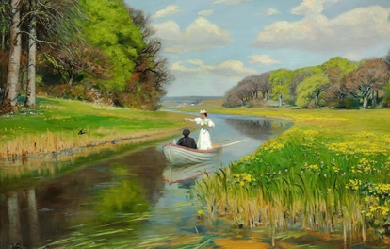
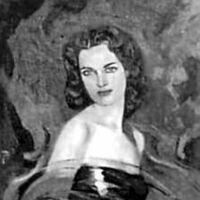
Stella Sierra (Aguadulce, provincia de Coclé, 5 de julio de 1917 - Ciudad de Panamá, 1997) fue una poetisa y escritora vanguardista panameña. Realizó estudios primarios en su ciudad natal, trasladándose después a la ciudad de Panamá donde obtiene el bachillerato en letras y comercio. En 1954 se gradúa de profesora de español en la Universidad de Panamá, estudia Letras y Filosofía. Se caracteriza por escribir poesía de raíz pagana y tiene muy en cuenta lo hispánico desde el punto de vista formal. Sus poesías contienen motivos amorosos y de pasión, los cuales son inspirados por la naturaleza y las ganas de gozar la vida. Además, ella utiliza un lenguaje de dignidad pura y mucha estetica. Su estilo es formal, tropical y pagano. Generalmente, sus fuentes de inspiración son la naturaleza y el goce de vivir en ella. Su poesía es rica en metáforas e imágenes y una buena parte de ella se encuentra en valiosas antologías nacionales e internacionales.


https://www.revistaikaro.com/poemas-de-athenea-stone/ LA SOLEDAD Soledad es la sonrisa tímida que se deja entrever mientras todos esperan cántaros de lágrimas de sal; la soledad es agradable cuando puedes beber copas de tus dolores pasados y no dejar gota de ellos. Soledad es la certeza de que tomaste las decisiones apropiadas sobre las acciones erróneas, que te permiten continuar el sendero de un futuro claramente incierto. Athenea Stone
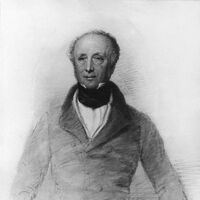
Horace Smith (born Horatio Smith) (31 December 1779 – 12 July 1849) was an English poet and novelist, perhaps best known for his participation in a sonnet-writing competition with Percy Bysshe Shelley. It was of him that Shelley said: “Is it not odd that the only truly generous person I ever knew who had money enough to be generous with should be a stockbroker? He writes poetry and pastoral dramas and yet knows how to make money, and does make it, and is still generous.” Smith was born in London, the son of a London solicitor, and the fifth of eight children. He was educated at Chigwell School with his elder brother James Smith, also a writer. Horace first came to public attention in 1812 when he and his brother James (four years older than he) produced a popular literary parody connected to the rebuilding of the Drury Lane Theatre, after a fire in which it had been burnt down. The managers offered a prize of £50 for an address to be recited at the Theatre's reopening in October. The Smith brothers hit on the idea of pretending that the most popular poets of the day had entered the competition and writing a book of addresses rejected from the competition in parody of their various styles. James wrote parodies of Wordsworth, Southey, Coleridge and Crabbe, and Horace took on Byron, Moore, Scott and Bowles. The book was a smash, and went through seven editions within three months. The Rejected Addresses still stands the most widely popular parodies ever published in the country. The book was written without malice; none of the poets caricatured took offence, while the imitation is so clever that both Byron and Scott claimed that they could scarcely believe they had not written the addresses ascribed to them. The only other collaboration by the two brothers was Horace in London (1813). Smith went on to become a prosperous stockbroker. Smith knew Shelley as a member of the circle around Leigh Hunt. Smith helped to manage Shelley's finances. Sonnet-writing competitions were not uncommon; Shelley and Keats wrote competing sonnets on the subject of the Nile River. Inspired by Diodorus Siculus (Book 1, Chapter 47), they each wrote and submitted a sonnet on the subject to The Examiner. Shelley's Ozymandias was published on 11 January 1818 under the pen name Glirastes, and Smith's On a Stupendous Leg of Granite, Discovered Standing by Itself in the Deserts of Egypt, with the Inscription Inserted Below was published on 1 February 1818 with the initials H.S. (and later in his collection Amarynthus). After making his fortune, Horace Smith produced a series of historical novels: Brambletye House (1826), Tor Hill (1826), Reuben Apsley (1827), Zillah (1828), The New Forest (1829), Walter Colyton (1830), among others. Three volumes of Gaieties and Gravities, published by him in 1826, contain many clever essays both in verse and prose, but the only piece that remains much remembered is the “Address to the Mummy in Belzoni's Exhibition.” Horace Smith died at Tunbridge Wells on 12 July 1849. References Wikipedia – http://en.wikipedia.org/wiki/Horace_Smith_(poet)

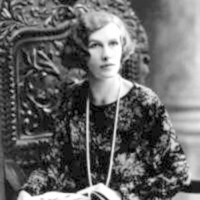
Muriel Stuart (1885, Norbury, South London– 18 December 1967), born Muriel Stuart Irwin, was a poet, the daughter of a Scottish barrister. She was particularly concerned with the topic of sexual politics, though she first wrote poems about World War I. She later gave up poetry writing; her later publications are on gardening. She was hailed by Hugh MacDiarmid as the best woman poet of the Scottish Renaissance although she was Scottish only by family origin and lived all her life in England. Despite this, his comment led to her inclusion in many Scottish anthologies. Thomas Hardy described her poetry as “superlatively good”. Like other female poets of her era, she reflects the weight of social expectations on women and the experience of post-war spinsterhood. Her most famous poem, “In the Orchard”, is entirely dialogues and in no kind of verse form, which makes it innovative for its time. She does use rhyme: a mixture of half-rhyme and rhyming couplets (a, b, a, b form). Other famous poems of hers are “The Seed Shop”, “The Fools” and “Man and his Makers”. She married twice, the second time to the publisher Alfred William Board. Later in life she stopped publishing poetry and wrote books on gardening: Fool’s Garden (1936) was a best-seller and Gardener’s Nightcap has been reprinted by Persephone Books.
I am a "Cajun", which is a shortened name for Acadian. I went to a country school and our senior class of twelve was much larger than the previous year's class of four. I went to the University of Northwestern Louisiana. I was a teacher for seven years before leaving to become a salesman. I started a retail packaging company and owned it from 1981 to 2012. I am retired and am very active with my half acre garden. I use a Farmall Super A tractor with implements to work it. I write as I am inspired, but mostly in the mornings when my pen finds its purpose.






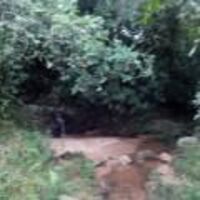

.JPG)
.JPG)

